FORESTRY & TIMBER NEWS

April 2023 Issue 116
IN THIS ISSUE:
CAREER DEVELOPMENT & WORKFORCE
CONFOR AWARDS WINNERS
APPG ON FORESTRY & TREE PLANTING


April 2023 Issue 116
IN THIS ISSUE:
CAREER DEVELOPMENT & WORKFORCE
CONFOR AWARDS WINNERS
APPG ON FORESTRY & TREE PLANTING

Offering a complete nutritional package for forestry, woodlands and Christmas trees:
l G AFSA Unground Rock Phosphate
l Protected Nitrogen to optimise efficiency
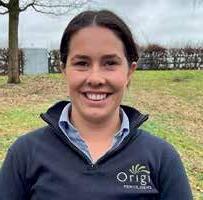
l Controlled Release Fertilisers for planting hole
-Available up to 2 seasons
-Available in 1.2 & 25kg bags
l New, in-house heat-sealed 25kg bagging line
l Broad spectrum soil and foliar analyses
l Fertiliser advice and recommendations
l NUTRI-CO2OL independently verified product carbon footprint
Technical enquiries:
Commercial enquiries:
forestry@originfertilisers.co.uk

Peter Scott - forestry@originfertilisers.co.uk
Now available from Green-tech Contact: 01423 332100
sales@green-tech.co.uk
www.green-tech.co.uk
Julia Andrews -28 Enabling education across the landscape: Lantra Scotland MARKET



40 The balancing act in today’s timber market

42 Forestry more cautious as global factors begin to bite
46 UK workers and the right to request predictable working patterns FISA 52 Ensuring FWM competency
61 Still some appeal to petrol power
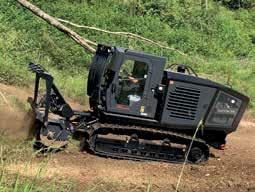
BODOWEN WOOD
Llanegryn, Tywyn, Gwynedd
8.40 Acres / 20.76 Ha
A small well-stocked second rotation commercial Sitka spruce plantation with direct road access. Freehold.

Offers over £140,000
GWERNILLA PLANTATION
Gladestry, near Kington, Powys
12.65 Acres / 5.12 Ha
Second rotation conifer woodland with trees well-established. Investment opportunity into a young woodland. Sporting rights included.

Offers over £70,000
Penybontfawr, near Llanfyllin, Powys
106.63 Acres / 43.15 Ha
A superlative well-managed commercial forest of distinct quality on an upland fertile site. Good access. Sporting rights are included.

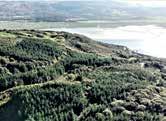
Offers over £675,000
REEDSHAW MOSS
Keighley Rd, Cowling, North Yorkshire
134.94 Acres / 54.61 Ha
An impressive commercial woodland planted in the 1970s on Ickornshaw Moor. Good conifer planting ground with superb vehicular access.
Guide price £1,200,000
ALLUMS GROVE & HAIND PARK WOOD
Kempley Road, Dymock, Glos.
In all, 153.47 Acres / 62.10 Ha



For sale as a whole or 2 lots. Superb multi-purpose woodland. Large quantities of mature fir, spruce, oak. Road frontage. Good access. Guide prices £820,000 & £830,000

BIRCHAM WOOD
Newland, Coleford, Gloucestershire
49.74 Acres / 20.13 Ha
Rare opportunity to own a mixed woodland within the boundary of the Forest of Dean. Forestry potential, wildlife haven. Sporting rights included.

Offers over £350,000
TUDBEER & PAINTMOOR WOODS
Chard, Somerset
In all: 39.8 Acres / 16.1 Ha
2 well-managed commercial Somerset woods with some amenity value. Sporting included. Lot 1 - offers over £190,000
Lot 2 - offers over £122,000
COED GLYNCLYGYROGWEN
Near Machynlleth, Powys
273.78 Acres / 110.79 Ha
A medium to long-term commercial forestry investment benefiting from outstanding aesthetics in a great location. Sporting included.


Offers over £1,800,000

For anyone like me who’s fascinated by politics, the recent goings-on at Westminster and Holyrood have been compelling. When not working or indulging in Six Nations rugby, I must confess to spending too much time scanning various news outlets for the latest updates and perspectives.

plateauing and the current review of the Forestry Grant Scheme seems to indicate a desire by the Scottish Government to reduce the proportion that is productive.


Just a few months ago, these two parliaments were in very different places –Holyrood had experienced 15 years of SNP dominance and only two First Ministers, while Westminster appeared to be intent on stacking up former Prime Ministers indefinitely.
Fast forward to mid-March: Nicola Sturgeon has resigned, and the SNP leadership election was described by its own interim CEO as a “terrible mess”. Meanwhile, Rishi Sunak is winning greater backbench support than expected and appears all set for the next General Election.
My reason for referencing this change in political fortunes is to draw a parallel with developments relating to our industry.
Six months ago, I would have pointed to Zac Goldsmith’s apparent antipathy to conifers in England, as well as the continuing loss of productive forest and lack of new planting, and contrasted that unfavourably with over 80% of new planting taking place in Scotland over the last five years.
But that comparison looks different now. New planting in Scotland appears to be
Confor is a membership organisation that promotes sustainable forestry and wood-using businesses. Confor members receive Forestry and Timber News for free as part of their membership. For more information on membership, visit www.confor.org.uk/join-us
Past issues and articles can be accessed online at www.confor.org.uk/news/ftn-magazine
Non-member subscriptions: £71.50/(£77 overseas)
Contact FTN@confor.org.uk
Forestry and Timber News is published by Countrywide Publications on behalf of Confor.
For advertising, contact Dan Rice 01502 725858
daniel.rice@micropress.co.uk
Printed by Micropress Printers Ltd
Stuart Goodall

Chief Executive
T: 0131 240 1416
E: stuartg@confor.org.uk
Andy Leitch
Deputy Chief Executive
M: 07881 510171
E: Andy.leitch@confor.org.uk
Eliza Hibbins-Cline
Membership and Marketing
E: eliza@confor.org.uk
Eleanor O’Neill
Communications Manager
M: 07918 255930
E: eleanor.oneill@confor.org.uk

Richard Hunter
Technical and Industry
Support Manager
M: 07867 379657
E: richard.hunter@confor.org.uk
Meanwhile, the English Forestry Minister is keen to be involved in drafting a National Wood Strategy and wants to meet soon with Confor and Friends of the Earth to discuss developing a wider sector deal for timber.
Trudy Harrison has spoken of ‘taking a chainsaw’ to the time it takes to plant a forest, and both she and Forestry Commission CEO Richard Stanford have rejected the narrative of some NGOs that conifers are somehow ‘evil’.

In Wales meanwhile, the government is working with Confor to increase planting and use more home-grown wood. Though still low, planting levels appear to be increasing.
Making comparisons can be healthy, not least because they point towards what can be achieved and they encourage people to look for lessons that can be learned from other’s experiences. They can also indicate a direction of travel.
When it comes to new planting and supporting the industry, the Scottish government has rightly held the Four Nations bragging rights in recent years, but there are now other administrations ready to compete for that title. The question is whether Scotland has the desire and the means to stay atop the table in the coming years.

Anthony Geddes
National manager for Wales
T: 07494 079305
E: anthony@confor.org.uk
April Armstrong
National Manager for Scotland
M: 07780 190821
E: april.armstrong@confor.org.uk
Miriam works with Natural Resource Wales as a Specialist Advisor in Land Stewardship. She took a more academic route into the industry, albeit after a detour.

“I really came to forestry by a happy accident. Despite growing up in a rural area with plenty of forestry going on, it wasn’t something I was aware of through my school career,” she said.
“After studying Natural Sciences at University, I found myself working in a lab and longing to be doing something in the environmental sector that felt ‘real’ and meaningful. I put in a chance application to the Forestry Commission’s Graduate Programme and haven’t looked back since.”
Miriam certainly found what she was looking for. “I love working on new woodland creation projects and knowing that we
are creating something that will be there for future generations to come, with all of the wonderful things trees and woodlands bring with them.”
She added: “I also really love the people who work in forestry. There are so many passionate, knowledgeable, and generous people in the industry; it’s an honour to be amongst them. I have been hugely lucky to be surrounded by so many supportive colleagues.”
However, it’s difficult to ignore that women are still a minority in most industry discussions.
“You’re often the only woman in the room or wood, smiling your way through awkward (sometimes well-meaning) comments or jokes,” Miriam said. “I have sometimes felt overlooked or underestimated in terms of my knowledge and capability and have had to deal with dismissive or patronising comments.
“It doesn’t have to be anything major for it to all add up and erode your confidence.”
Despite these experiences, finding a supportive group makes all the difference.
“I have attended a range of courses, webinars and conferences, initially to learn the basics and now to expand my knowledge. As well as the practical and theoretical learning you can take away and put into practice, it’s a great way to meet fellow professionals and create a network.
“There may be fewer women in forestry than men, but the ones that are here make up for that in impact. I have been hugely lucky to have had some excellent female colleagues and managers in my career to date. I have found them a constant source of support. Whether that is mentoring, friendship or inspiration from afar.
“In Wales, we recently set up a networking group for women in forestry, and I hope that will mean that any women who don’t currently have female colleagues they can look to for advice will find them.”
Caitlin is Forest Manager on the Seafield and Strathspey Estates in the Scottish Highlands. Her introduction to forestry came via a favour for a friend.
“They asked me if I could use my horse to extract some timber for them. That first job sparked an interest in an industry I knew nothing about, but I loved it,” she said. “I started my horse logging business with minimal forestry knowledge and worked from there to where I am today.
“There are a number of things I love about my job as a Forest Manager. The main ones have to be the responsibility for managing such a beautiful landscape, the

variety and complexity of estate management, the sense of achievement, and being able to work outdoors with my dogs each and every day.”
Caitlin’s experience of finding a place within the sector has had its pitfalls but has ultimately been shaped by her own determination to succeed.
“The forest industry has come a long way from where it started but there are still a number of barriers that may be offputting to women entering the sector,” she noted. “These include big things like the perception that forestry is a man’s game, and minimal maternity cover offered in the private sector - but also go down to the small things like the fact I still can’t buy
chainsaw PPE that fits me!
“Over the last 12 years, I have come across two types of managers: those who want to support me, and those who want to hold me back. Oddly, the latter were both women. I have tackled all the barriers that I’ve faced in the same way; I want to do it, so I’m going to do whatever it takes to get there. I see other people’s doubt in me as a challenge to prove them wrong.”
Considering how more women may find their way into forestry, Caitlin explained which opportunities made the most difference for her and why support is key.

“Barriers won’t all be the same for everyone so there is no easy fix. There is funding out there to help financially with train-
ing, there are groups just for women, and there are many companies and individuals in the industry that will go out of their way to help.
“I take any opportunity I can get to upskill, develop, and grow my knowledge and skill. Forestry is constantly growing and evolving so there is always something new to learn. I have really been helped by the funding options that are available out there and a lot of the additional training I’ve done wouldn’t have been possible without them.
“I would love to be there to support any other women in forestry who could use advice, support or mentoring because this would have really helped me.” continued on p8
continued from p7
Liz founded Sharkey Forestry Ltd in 2014 and has over 20 years’ experience in the industry. However, her career didn’t get off to the smoothest start.

“I was led to believe I was taking a gardening job, and on my first day I found out I was the only female employee amongst a team of 10 men. I couldn’t even lift the knapsack sprayer onto my back!
“This was tough at the time as I had to prove myself capable of doing the job but, in hindsight, it was the best opportunity I could ever have been given: it gave me the essential experience on the ground that kickstarted my career.”
Though she hadn’t intended to get involved in forestry in the first place, Liz doesn’t regret it.
“It never escapes me how lucky I am to be doing a job that I love. Once you’ve gained enough experience, you have the freedom to focus on whatever part of forestry you like the most. For me that’s managing estate woodlands, working with contractors, and writing 10-year Woodland Management Plans.
“I became a Chartered Forester in 2015, which was a big achievement for me. As I work for myself, having a support network is really important and joining groups such as Confor and the Institute of Chartered Foresters provides the level of support I need and gives me access to a variety of learning resources to help me keep up to date with industry news.”
After so long in the sector, Liz has noticed a change in the demographics around her.
“When I started in forestry it was so male dominated, from the contractors on the ground up to the agents who were also often of the older generation. It’s so different now, there is a lot more diversi ty,” she remarked. “One person in particu lar stands out to me.
“I met Caroline Ayre at the APF, prob ably around 2008, and I remember be ing completely surprised to see a woman working in forestry who was so outgoing and who also clearly had the respect of the people working around her.
“Looking back now, I guess in the beginning I felt that I had to conform to what men expected of me so that I could fit in and be accepted. I didn’t have the confidence to really be myself. I really think we underestimate the impact we can make on each other in forestry - just one brief meeting with a like-minded per son can provide the inspiration and confi dence needed to carve out a whole new career.”
On 21 March, the Scottish Government launched a Women in Forestry Practical Training Fund, thanks to the support of Scottish Forestry and the Skills group of the Scottish Forestry and Timber Technologies ILG
The aim of the fund is to support the personal development of women, presenting them with greater opportunities for training resulting in the provision of additional skills that will progress their careers and employment opportunities in forestry beyond their current role, while also helping to address the current gender imbalance within the sector.
The fund is open to any woman resident in Scotland who is either already working or studying in the sector, or who is keen to start work in this area and can demonstrate how the training course will support the development of their business or employment options.
Eligible training up to the value of £500 per course will be fully funded; any training over the value of £500 per
course will be considered and as sessed on a case-by-case basis. Applicants are urged to pro vide comprehensive details regarding the benefits of the course to their particu lar situation to allow the panel to best assess appli cations.
The fund has been devel oped by Lantra Scotland and is hosted via SkillSeeder. Lan tra is the leading awarding body for land-based and environmental training in the UK and SkillSeeder is a trusted platform for the provision of quality training and acts like a skill-sharing marketplace, connecting providers with students.
Together they have created the SkillSeeder Women in Forestry Badge, which makes it quick and easy to find an eligible training course for application to the fund, and to filter offerings by location and subject area. However, if a course

you are interested in isn’t listed on the site, new eligible courses can be added to the platform via a Course Request Form.
Applicants are encouraged to submit an application as soon as possible whilst allocatable funds are available!
For more information or to apply, please visit the SkillSeeder Women in Forestry Practical Training Fund page (www. skillseeder.com/women-in-forestry) and simply look for the Women in Forestry Badge to find a variety of courses compatible with the Women in Forestry Practical Training Fund.
Lantra Scotland and SkillSeeder are also inviting training providers to get involved. If you have a course which you feel would be suitable for the Women in Forestry Practical Training Fund, then please email the SkillSeeder team at hello@skillseeder.com.
“WHEN I STARTED IN FORESTRY IT WAS SO MALE DOMINATED... IT’S SO DIFFERENT NOW, THERE IS A LOT MORE DIVERSITY.”
+10% FASTER CUTTING. QUICKER SHARPENING. LONGER SERVICE LIFE.
A brand new professional cutting system exclusive to STIHL. Setting new standards for chain performance, the Hexa saw chain has a narrower kerf on the cutting teeth, which provides a 10% improvement in cutting performance for maximum output during work.

Sharpening the chain is quicker than ever before – the Hexa file sits perfectly in the profile of the cutting tooth thanks to its hexagonal shape. This means you’ll always achieve the ideal sharpening angle and as a result, the saw chain will have a high quality finish so it stays sharp for longer.
Designed with professionals in mind, the Hexa saw chain is compatible with all professional petrol chainsaw models from the MS 362 - MS 661.
PROFESSIONAL CUTTING SYSTEM: STIHL HEXA SAW CHAIN. AVAILABLE AT YOUR

THE IDEAL SAW CHAIN AND FILE FOR FORESTRY AND HARVESTING.

John is an accomplished forester with 24 years’ experience in operational leadership of Forestry and Land Management programmes in England’s public forests. He graduated from the University of Edinburgh in 1998 with a degree in Ecological Science with first class honours in Forestry.

He fulfilled his long-term dream of working in forestry in 1999 when he joined the Forestry Commission in Thetford Forest, managing a large harvesting programme and leading preparations for England’s first ever timber certification audit. After two years, John was promoted to District Forester in Southeast England; producing forest plans and leading timber harvesting.
John quickly secured promotion to Operations Manager in the Lake District, where he led five Beat teams and functions to deliver productive upland forestry. He greatly valued the partnership with timber customers and contractors throughout this period, including a coordinated response to the 2005 Cumbrian storms and the associated windblow clearance.
In 2012 he returned to Thetford Forest as Head of Land Management for East England, where he led a large team of 60 staff across nine beats. He undertook two spells as Acting Forest Management Director that allowed him to attain a wider appreciation of the business and develop wider stakeholder management skills.
John’s focus over the past few years
has been in delivering high-quality forest and land management programmes, including achieving major savings through operational efficiency and creating, resourcing, and leading a forest change programme to make forests more resilient against future pressures.
Working within public forests in Northwest and East England has taught him much about successfully delivering economic objectives alongside other priorities in sensitive landscapes with large populations and diverse users and stakeholders. John has overseen some £100m timber income during his tenure, so holds
a wide appreciation of the critical role that timber and wood-based products play in the sustainable management of our woods and forests.
The opportunity to work across the whole forest industry in England greatly attracted John to the National Manager role and a new challenge. He wants to use his expertise and knowledge to help bring the forest industry ever closer together in England (as well as cross-border), to inspire organisations, politicians and society to tackle climate change through the opportunities in the England Trees Action Plan, and to champion the important role that timber and other wood-based products will play in mitigating the climate and biodiversity emergencies we face.
John said: “I am delighted to be joining Confor in as the new National Manager for England. Caroline Ayre was a great ambassador for the Forest Industry and will be a huge pair of shoes to fill.
“I will work my hardest, bringing all my forestry expertise and passion for the industry to bear, and to continue to build on the fantastic legacy Caroline leaves behind. There has never been a bigger opportunity for Forestry in England, and we must seize this moment for the betterment of our climate, people, biodiversity and the economy.”

The Confor Dinner and Awards 2023 has come and gone. For those who attended, I hope you enjoyed the evening and felt inspired by the winners and finalists. It was fantastic seeing so many familiar faces and it was a great
event for the industry.
If you have any feedback on the evening, feel free to contact me at members@ confor.org.uk. I would also like to offer a shoutout to Cornwall-based Jamie Zennor Downes-Atkins for creating the bespoke awards! You can find more details at zennormade.com.
We are still encouraging Members to sign up to our online Member Directory. With our website receiving over 100,00 views in 2022, the Directory offers a great opportunity to promote your business for
free. It’s easy to get involved: simply upload your contact details via our Members Area! If you require any assistance, please get in touch.
Finally, a warm welcome our new Members: Neil Purves (Elliot Henderson Ltd) in Scotland; and Paul Smith, Colin Norman (PhD Student), Liam Howes (Working Woodlands), and Tom Coxhead (Leeds Coppice Workers) in England.
Contact Eliza on 07918 880285 or email eliza@confor.org.uk
“THERE HAS NEVER BEEN A BIGGER OPPORTUNITY FOR FORESTRY IN ENGLAND.”
Argyll & Bute
2,200 Hectares / 5,436 Acres
Freehold & leasehold for sale as a whole.
Offers over £29,000,000
A rare opportunity to acquire an excellent quality large-scale, commercial conifer forest with a mixed-age structure. Well located in West Scotland.

For further details, please contact: Jon Lambert MRICS jon@goldcrestlfg.com 07900 320 475
Jack Galbraith MRICS jack@goldcrestlfg.com 07951 177 323
Lochgilphead | Argyll & Bute 97.65 Hectares / 241.30 Acres
Freehold for sale as a whole
Offers over £995,000
An excellent opportunity to acquire a compact, high quality, second rotation commercial conifer forest. Well located in Argyll.

For further details, please contact:
320 475

Jack Galbraith MRICS jack@goldcrestlfg.com 07951 177 323


Office: 01292 541145
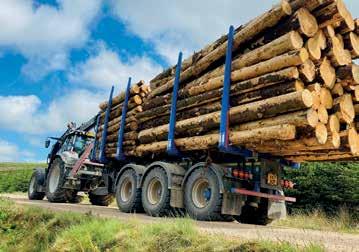


Adam Howie: 07792 804273

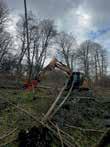


spoke at the event, said: “It was great to hear the Minister’s continued positivity about increasing productive forestry, to secure future timber supplies and avoid an ever-increasing reliance on imports.


“She was also very supportive of the National Wood Strategy, and asked for a meeting, which we will arrange to discuss the Strategy and Timber Sector Deal.”
Tom Barnes welcomed the Minister’s positivity, and the Forestry Commission’s aim to make productive planting simpler and to tackle the negativity that can surround it. However, he warned that England was currently “going backwards on productive forestry” and had to turn positive
words into action.
Mr Barnes added: “We are at a ‘now or never’ point. We have momentum and desire and we’re hearing all the right things, but must turn that into action. Process-
Ms Harrison said this would involve a clear “presumption to plant” in appropriate areas, and constant work on addressing barriers that stopped people planting trees. Naomi Matthiessen, who leads on forestry at Defra, said there were short, medium and long-term policies in place to remove barriers, which should have an impact from the next planting season.
Trudy Harrison reaffirmed the Government’s desire to increase the UK’s tree and woodland cover to 16.5% (from 14.5%) by 2050. This would require 250,000 hectares of new woodland, and around 400 million new trees. She added: “It’s an am-
continued on p14
continued from p13
bitious target, but absolutely necessary to support timber in construction. We need a mixture of coniferous forests, mixed woodland and broadleaf trees.”
She asked for a specific figure of what needed to be planted to provide the wood needed for construction and other uses. Stuart Goodall said Confor has commissioned a specific piece of work to enable that to be calculated more accurately.
Around 30,000 hectares of productive forestry in England have been lost in the last decade, he said, and timber supplies from UK forests are forecast to fall from the late 2030s, just as global demand begins to peak as the world aims for Net Zero by 2050.
Paul Brannen of CEI-Bois said at least 50% of new UK planting had to be woodproducing forests, while Guy Opperman, Conservative MP for Hexham, said this was the “bare minimum”. He called for a “kitchen table approach” to new small planting schemes where all interested parties got together early in the application stage to prevent unnecessary and lengthy delays.
Baroness Young, speaking as a Food, Farming and Countryside Commissioner, reinforced the need for all kinds of planting. “It’s not about either/or, conifer/ broadleaf - it’s both/and,” she said. “If the tide rises, all the ships float.”
She thought the 16.5% target was unambitious and should have been higher, but added she was “really keen” on the idea of a Timber Sector Deal.
Minister Harrison noted that Sector Deals had worked in other areas and said she was happy to facilitate discussions to create a successful Timber Sector Deal.
Paul De Zylva of Friends of the Earth said a Deal did not have to be prescriptive, and the most important thing was “bringing the brains into the room together to solve the problems”.
Stuart Goodall said: “We have the Government, industry, environmental NGOs and farmers all saying we can do something really positive. Producing more of the wood we consume in the UK is supported by everyone I speak to. We need to think global and plant local.”
He said key elements of a Deal might include how to get more timber into construction, attract more people into the industry and scale up the supply chain, from nurseries through to wood processors.
Baroness Young said the way to engage farmers was through agroforestry, to “get them comfortable with small-scale planting before they do the more heroic stuff”.
Summing up, APPG Chair Ben Lake MP thanked the Minister for her very positive contribution and confirmed that the APPG was very supportive of a Timber Sector Deal and wanted to be kept updated on progress.
Confor organised a visit for Peter Fox MS to an award-winning planting scheme just outside the village of Devauden on 13 March.
The first site in Wales to be accredited to the Woodland Carbon Code, the 215acre planting project has seen 165,687 new trees put in the ground since 2009 and was the gold medal award winner for best broadleaf woodland of between 11 and 40 years growth at the Royal Welsh Show 2022.
Designed and managed by Pryor & Rickett Silviculture, it has been planted under the Glastir Woodland Creation scheme to create a diverse and resilient woodland for the area, showcasing the opportunities that mixed planting and the timber sector can deliver for Monmouthshire’s economic growth.
Director at Pryor & Rickett Andrew Sowerby explained during the visit that his firm had been briefed to design a woodland that would support their client’s values of strong environmental stewardship, carbon capture and timber security.

Anthony Geddes, Confor National Manager for Wales, outlined the work Confor is doing to lift barriers to tree planting and secure the long-term sup-
ply of domestic timber that is needed to drive up the numbers of timber-based, more eco-friendly housing.
Thanking Peter for his time, he said: “Peter’s experience as a farmer and his commitment to sustainable land management is welcome. It was very positive to hear him talking about the importance of woodland management as a way of reconnecting farmers with parts of their farm to support them under the proposed new farming scheme.
Anthony also discussed how woodland creation could work within the proposed Sustainable Farming Scheme to help farmers secure the resilience of their businesses, either through environmental and carbon incomes or through diversification to produce timber and fibre for the wood processing sector.
Mr Fox added: “It was fantastic to hear in-depth of the great work Confor is carrying out to improve the environment. I thank Confor again for the invitation to join them.”
Both Peter and Anthony felt that there needed to be clearer sign posting about the benefits and access to support for woodland management as it was key to start rebuilding the link between farmers and forestry.
ROOTED IN SCIENCE, DERIVED FROM NATURE
The latest addition to the Tubex range is designed to perform, providing the same high levels of browsing protection and growth facilitation expected from the standard Tubex range. Ideal for areas with dense woodland or limited access, Tubex Nature Biodegradable Shelter is the most responsible alternative where collection and recycling is not practical.
Manufactured using a bio-based blend, including sugarcane, corn and starch, Tubex Nature Biodegradable Shelter can be left to biodegrade in situ and will, over time, start to degrade and breakdown into water and CO2 through a microbiological process.
Benefits:
• Biodegradable in situ: Externally tested against ISO 17556 to demonstrate soil biodegradability

• Bio-based: With materials derived from sugarcane, corn and starch
• Non-toxic: Externally tested against OECD 207 and 208
• Proven performance: Tested to perform with expected 5-year service life with a robust twin-walled construction, while providing excellent light transmission to facilitate growth
• Easy installation: Includes pre-fitted re-release ties
Nature Range Styles
Nature Standard
Nature Ventex
Nature Voleguard
Nature Easywrap
Nature Shrubshelter
Tubex Nature is the first biodegradable tree shelter to combine externally tested soil biodegradability with scale of manufacture and proven performance.





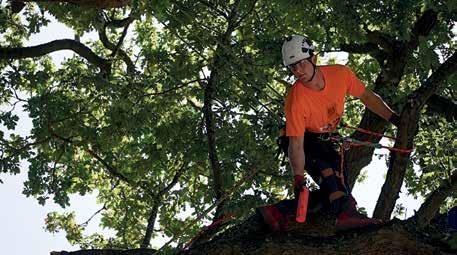

The Confor Dinner & Awards 2023 took place in Edinburgh on 28 February, bringing leading figures of the industry together to celebrate another year in forestry and wood. Reporting by David Lee and
Anew cohort of awardees were recognised at the Confor Dinner & Awards 2023. Future forestry leaders, great communicators and inspiring innovators were among those given accolades at the event, which welcomed more than 200 representatives of the industry to Edinburgh.

“You are doing good work, and that should be celebrated,” said Confor Chair Lord Ian Duncan, kicking off the evening at Surgeons Quarter.
He then introduced keynote speaker Màiri McAllan MSP, Scotland’s Environment and Land Reform Minister, who said she was proud to have responsibility for forestry and described it as “a thriving and successful industry looking to the future”.
Confor and its Members are “integral” to delivering an enormous range of economic, environmental and social benefits, she continued, adding: “But we must challenge ourselves to be adaptive and better.”
“Forestry is so central to what we need to do, and Government support and targets will continue to drive that. But change can be unsettling for communities, and I will support in every way I can the many benefits forestry can deliver.”
Ms McAllan stated that bringing communities into discussions at an early stage could avoid problems further down the line, as Scotland faced up to climate change, biodiversity loss and land use change.
“Private and public sector collaboration is very important to me,” she said. “We suc-
Eleanor O’Neillceed better in facing challenges when we collaborate - and I’m committed to working with you to mitigate them, and to take all the opportunities.”
She also urged Members in Scotland to reply to the Forestry Grant Scheme consultation, saying: “We seek your views and collective wisdom. How do we secure more carbon sequestration, biodiversity recovery, improved economic activity, foster good relationships with communities, and ensure a sustainable supply of timber to the wood-using industry?”
Confor are preparing an industry response to this consultation, as well as a template for Members who may wish to have their say and magnify the impact of continued on p18
strong, is leading on this and welcomes in put ahead of the 17 May deadline.
The first award of the evening was presented by the Scottish Forestry Trust (SFT) to mark the organisation’s 40th anniversary. The Award for Education and Outreach recognised two projects that have contributed to broader public knowledge and engagement with forestry.

Paul Atkinson, SFT Trustee and Founding Partner of Par Equity, presented the awards to the team behind Cashel’s Forest Centre, and to the Scottish Council for Development and Industry’s Young Engineers and Science Clubs, an initiative supported by Confor.

Next, Jonathan Callis MICFor of Network Rail picked up the Professional Forester of the Year Award, sponsored by the Institute of Chartered Foresters (ICF). This was the first time this award had been presented at the Confor Dinner, and the judges were impressed by Jonathan’s pragmatic approach to the sustainable management of trees and woodland.
One of the few Chartered Foresters working in the rail industry, Jonathan is instrumental in setting policy and providing direction for the management of lineside vegetation. His effort in promoting technical membership of the ICF and his active engagement with colleagues in the rail industry resulted in several colleagues contributing to his nomination.
Tom Barnes of Vastern Timber was the winner of the Changing Attitudes Award, sponsored by Scottish Woodlands Ltd, for his work in sharing positive and accessible videos about forestry with a wider audience. The Wood for the Trees series of films on forest management and resilient woodlands has had more than 60,000 views on YouTube.
Tom is also helping to engage policymakers in the development of a national wood strategy for England, due to be published this year. He was unfortunately unable to attend the Edinburgh event, but was presented with his award by Forestry Minister Trudy Harrison MP in London and shared a video message on the night.
The Tom A Bruce-Jones Memorial Award for Future Leader in the Forest Industry, presented by James Jones & Sons,

“FORESTRY IS SO CENTRAL TO WHAT WE NEED TO DO, AND GOVERNMENT SUPPORT AND TARGETS WILL CONTINUE TO DRIVE THAT. BUT CHANGE CAN BE UNSETTLING FOR COMMUNITIES, AND I WILL SUPPORT IN EVERY WAY I CAN THE MANY BENEFITS FORESTRY CAN DELIVER.”
MÀIRI MCALLAN MSPGraham Taylor MBE was awarded Confor’s highest accolade. The Tom A Bruce-Jones Memorial Award. ICF Professional Forester of the Year.
was awarded to Neil White of Scottish Woodlands Ltd, who oversees mentoring and training on his organisation’s graduate programme.

He was described as a “rounded, confident, and highly competent senior manager” and, in addition to developing younger staff, he has undertaken significant training to hone his skills while managing some of the UK’s largest forests. (Read a Q&A with Neil on p20).
utilised aerial drone surveys linked to data dashboards to better inform deer management.
This project has both improved stakeholder engagement and supported wildlife management objectives.
A new award for contribution to Net Zero was also introduced this year, marking the industry’s vital contribution to addressing the damaging impacts of climate change. Sponsored by Tilhill, the accolade went to went to Neil Stoddart of Creel Maritime Ltd.



Neil is involved in many net zero projects across the country as Creel nis known for its focus on decarbonisation. He was

Forestry Commission and Forestry & Land Scotland (FLS) then presented the award for Innovation & Research. Representatives of BH Wildlife Consultancy took to the stage to accept the prize on behalf of their partnership with FLS, which has continued on p20
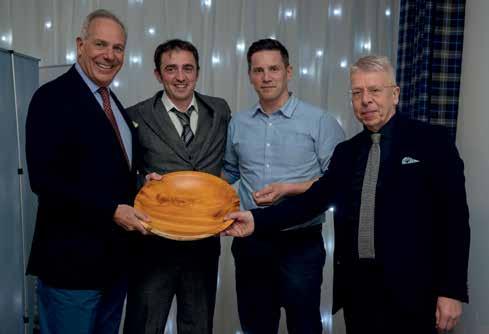
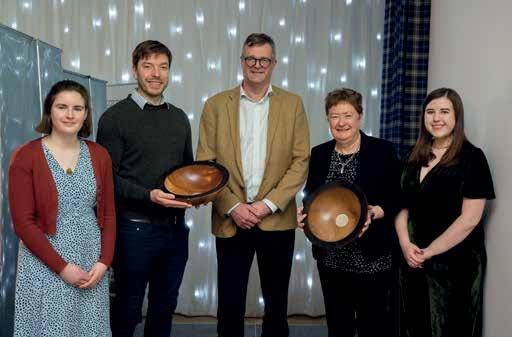
“THE FORESTRY INDUSTRY RELIES ON THE COMPETENCE AND SKILL OF ITS GREAT PEOPLE AND IT WOULD BE NOTHING IF IT WASN’T FOR THEM. ALL I HAVE TRIED TO DO IS SUPPORT PEOPLE, YOUNG AND OLD, IN THIS GREAT SECTOR.” GRAHAM TAYLOR MBEWinners of the SFT 40th Anniversary Award for Education and Outreach. BH Wildlife Consultancy & FLS presented with award for Innovation & Research. Stuart Goodall. Trudy Harrison MP with Tom Barnes.
praised for his work in ensuring the “the industry he loves so much remains sustainable, profitable – and ultimately cleaner and greener than the day he entered it”.
The final honour of the evening was the Dedicated Service to Forestry Award, this year presented to Graham Taylor MBE, Director at Pryor & Rickett, by Màiri McAllan MSP.
Graham said: “The forestry industry relies on the competence and skill of its great people and it would be nothing if it wasn’t for them. All I have tried to do is support people, young and old, in this great sector.”
Stuart Goodall, Chief Executive of Confor, highlighted Graham’s “passionate and energetic” work for the industry over three decades, and the numerous organisations he has been involved with outside Pryor and Rickett – including support to give unemployed people opportunities in forestry, work on tackling the scourge of tree damage by grey squirrels and bringing young people into the industry.
“He is a friend and colleague who cares passionately about people inside and outside the industry,” he added.
Several of the awards presented at the Dinner, including the Dedicated Service Award, were specially created for the evening by Cornish woodturner Jamie Zennor Downes-Atkins (www.zennormade.com). The Confor team would like to extend our thanks to him, to all the award sponsors, those who put forward a nomination, and the venue staff for contributing to a successful event.
Stuart Goodall said: “I would like to congratulate all the worthy winners –and their fellow finalists – recognised at our biggestever awards dinner. These Awards showcase the amazing talent that is driving the forestry and wood industry forward. We’re in great shape and stand ready, willing and able to tackle the big economic and environmental challenges ahead.”
The Forest Industries Education and Provident Fund are delighted to announce that over £1,500 was raised at the Confor Dinner & Awards through a prize draw to benefit the Fund. The lucky winner of dinner for two and a night’s stay at Ten Hill Place Hotel was Scott Sheils of Glennon Brothers. Our thanks to the attendees for their generous donations and we hope you enjoy your stay, Scott.
Neil White MICFor, Branch Manager for Scottish Woodlands Ltd, was awarded the Tom A Bruce-Jones Memorial Award for the Future Leader in the Forest Industry at the Confor Dinner & Awards 2023.



How do you feel about being named a ‘Future Leader’ of the industry?
It’s a huge honour to win this award. It’s been really unexpected and the field of shortlisted nominees was really strong.
I’m really pleased for this recognition, especially for my work with our graduate programme. It’s really a team effort and so this should be shared by everyone who makes it happen.
Has this always been where your career was headed?
I have wanted to work in forestry since I was nine or 10 years old. Growing up, I loved the outdoors and wanted to work in an active role. Forestry seemed to be a great fit for that.
Many people mistakenly think that forestry is too niche or specialised when it’s really an incredibly varied industry with so many different parts. That’s what I love about it.
How do you bring leadership qualities into your role?
I think about the great leaders that I know and the qualities that they display. The best leaders I’ve known are approachable, decisive and are passionate
about what they do. That passion and drive becomes infectious, spreading to others around them.
Good leaders should inspire those around them to take ownership and be willing to make their own decisions. Those are the qualities I try to emulate and encourage in those around me.
What has been the biggest achievement of your career so far?
I’ve been privileged to work on some of the biggest and most interesting woodland creation projects in a generation. Being part of that process is really humbling. There aren’t many careers where you get to create something permanent that will last for generations.
One standout project was a native woodland we created on an abandoned sand and gravel quarry near Kirriemuir. The trees are doing great, and the land has been transformed for the better.
It’s also been a real thrill to see the young people who have come through our graduate programme develop into competent and confident managers.

What comes next for you?
We have some really exciting projects coming up and I’m looking forward to getting stuck into them. It’s great to see woodlands that were planted in the 1980s and 1990s become ‘active’ and being managed and improved.
As I like to say – I don’t have problems. I have challenges I haven’t overcome yet.
“GOOD LEADERS SHOULD INSPIRE THOSE AROUND THEM.”Màiri McAllan MSP Neil Stoddart







Ian Robinson has taken up the helm at Scottish Woodlands Ltd, following the retirement of Ralland Browne after almost seven years in post.


Ian has worked with the company for 35 years, most recently in the role of Forestry Director.
He said: “It is a real honour to take the reins at such an important time in the development of our business and indeed the forestry and wood industry.
“We have an extraordinarily talented team of staff working across the UK, helping our clients manage their woodlands and forestry projects to achieve significant outcomes for new woodland
Roland Stiven recognises the achievements of Alistair Speedie over his tenure at the Timber Transport Forum.
planting, timber harvesting and the delivery of infra structure projects.
“The new Board would like to thank Ral land for his consistent and hard-working service over many years. We all wish him a well-earned retirement.”
Confor Chief Executive Stuart Goodall comment ed: “I am very grateful to Ralland both for the support and ad vice he has given to
It is easily forgotten, but our production forests were mostly planted in the second half of the 20th century - a few decades after our rural road network was generally adopted by local authorities. Before that most heavy rural freight went by rail or by coastal puffers.
When, in the 1990s, substantial areas of timber started being harvested from upland glens on 44-tonne trucks, there was a rude awakening: our road infrastructure was really not up to it.
At the time, Alistair was embroiled in a local stand-off with the timber industry over haulage from a certain Polbae Forest in Galloway. The Council was threatening to stop timber haulage because the road was being damaged, and the timber company was taking the council to court to say they couldn’t.
Alistair quickly realised that whichever way that landed, it would only serve to bring timber haulage to a grinding halt. He opted instead for a partnership approach – establishing relations with the timber industry, building trust and sorting out prac-
me personally and for his willingness to serve on both Confor’s Management and
“In his time on the board, Ralland has taken a lead on key areas of Confor’s activities. As an organisation, and as individuals, Confor benefits hugely from the time that Members make available to assist with and advise on our work.
“On behalf of the Confor team, I would like to wish Ralland all the very best for his retirement and we look forward to working with Ian to continue to help take the industry forward.”
tical ways of minimising the impact of timber transport while getting the timber to market.
Similar situations across Britain had prompted the creation of timber transport groups and a national Forum. Alistair was identified as the constructive face of the councils and quickly invited in. By 2004 he was chairing a GB-wide Forum and drawing up a Partnering Charter to give some formality to a voluntary liaison process.
Under his lead, the Forum proposed a Strategic Timber Transport Scheme to bring national (Scottish Government) cofunding in to improve timber transport infrastructure. Since 2005 the Scheme has invested £120 million into over 300 rural road improvement projects.
Agreed routes maps were drawn up, liaison protocols established, and good practice guides shared. Gradually timber transport issues became recognised as something that both foresters and councils had to sort out in partnership.
The problem hasn’t gone away – the volume of timber we harvest keeps increasing; much of the 10,000km of minor road we use in Scotland is still fragile; councils are still cash-strapped, and communities can still get up in arms about the impacts of big lorries on small roads. But we now know that most situations can be resolved in partnership through dialogue and trust.
There have been numerous people involved in the Forum over the years and the various arguments are regularly rerehearsed. Alistair has persevered with the idea of carefully creating relationships and making sure the various parts of the jigsaw are kept in place. Not to mention, all this has been achieved as a voluntary extra to his increasing responsibilities as Director of Services in the Council.
Our forests, sawmills, and roads are all in a better place thanks to Alistair Speedie, and we wish him well in retirement.

Euroforest Ltd are speci lists in Mechanised Arboriculture and offer a range of tree care and woodland management solutions to suit your needs:-
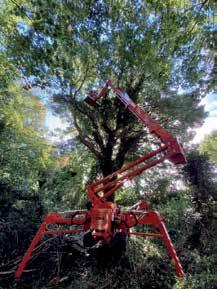
Mechanised Arboriculture
Tree H Health Surveys
Tree Maintenance
T Traditional Tree Surgery
Site Clearance & Mulching
Hedge & Verge Maintenance
T Tree Planting & Landscaping
idespread in erable liability ially adjacent ion is always
n the UK and offer a tailored approach to suit all requirements We use a range of specialist equipment, allowing us to safely dismantle any tree in any location All of our projects are professionally planned and managed from start to finish, enabling us to achieve and deliver the best results


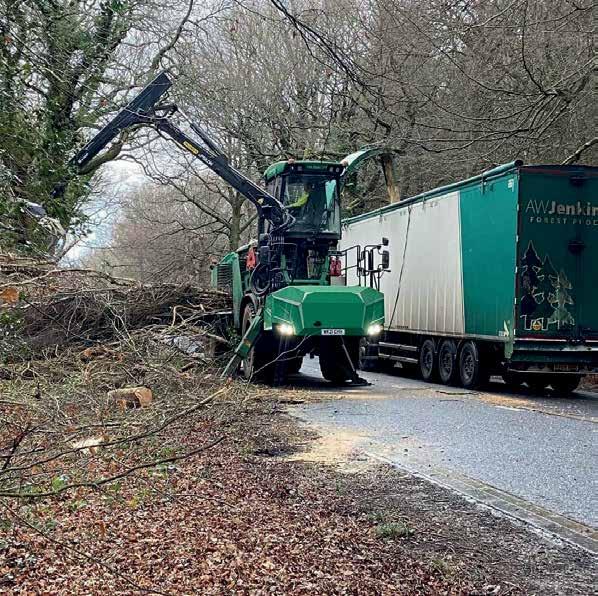
Our highly experienced team offer an industry leading Arboriculture service across the country We lead the way in compliance and public relations, setting a gold standard through our accreditation to ISO 45001 Occupational H&S Management and ISO 14001 Environmental Management Systems
Euroforest's specialist teams offer a bespoke service, from initial site appraisal through to completion and replanting We offer a service that puts the landowner centre stage while always minimising costs and maximising any timber revenues If you wish to find out more, please visit our website or call our Head Office
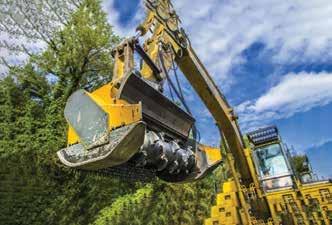

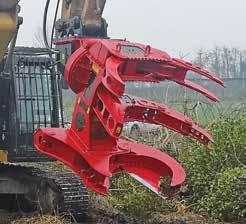




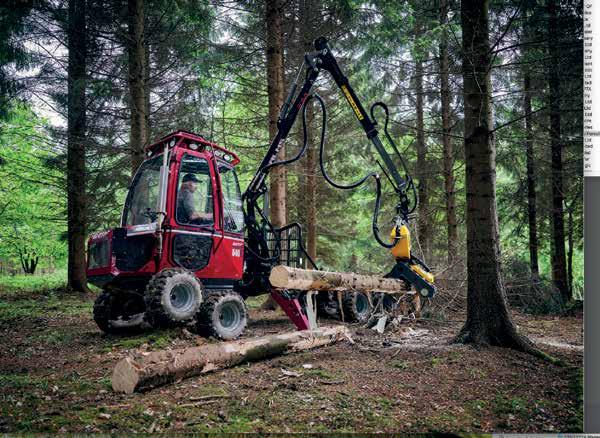


Forestry expert John Clegg is celebrating 40 years in the industry and has shared his unique insight into the current state of the UK woodland economy.
Now Director of Tustins, John started off in the family business. His father (also called John) set up John Clegg & Co in 1967, principally to assist companies looking to acquire rural estates and sell on areas which they did not wish to retain. At that point, sales were handled by rural or residential agents but there were no specialists selling woodlands.
As a result, John Clegg & Co started to sell woodlands with Angus Crow and Colin Gee heading up this service. As the younger John explained: “That was a niche market that grew swiftly, and I joined in 1983 to assist Colin Gee in dealing with sales and acquisitions in England and Wales. Consequently, we were well placed to assist the Forestry Commission with its sales throughout the UK. This programme greatly raised the public’s awareness of woodland ownership and our profile.”
Since then, John has “been involved in more woodlands sales than anyone else in the UK”, ac-
cording to fellow Director Mike Tustin, including transactions with celebrities such as Bryan Robson, Cliff Richard, Hugh Johnson and Brian May. He is excited about the future and is predicting current record levels of forestry investment and land values are set to continue.

John said: “There are record levels of forestry investment available – hundreds of millions of pounds - from institutions and individual investors and the change in value per acre during my career is notable. Roughly from £500 - £1000 in 1983 to over £25,000 per acre today and these prices will continue to be buoyant.”
John expects the woodland market to continue to improve because of increasing worldwide demand for timber. He added: “Demand is only going to increase because wood is a natural product. [The UK] could produce a much larger percentage of our own timber but that depends on how much land we want to transfer over to trees.
“I am very positive about the forestry sector which I believe has a great future particularly if the government’s target of 30,000 hectares per annum of new woodland creation can be achieved and this has a strong conifer content.”
Jean Balfour, an influential figure on the forestry scene for many years, sadly passed away in February. Shireen Chambers FICFor, Chief Executive of Future Woodlands Scotland, shares her memories of Jean and the legacy she has left behind.
Dr Jean Balfour CBE FRSE was well known to many, not just in forestry, but in land management and conservation far beyond Scotland. In her 95 years, she influenced so much that we now take for granted in our countryside.
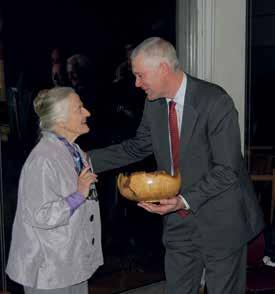
As owner of Scourie Estate in Sutherland and Balbirnie Estate in Fife she could put her knowledge of land management to good use, but her reach extended much further. She was influential in her role as Chair of the Countryside Commission for Scotland and her work on crofting as a founder member of the Scottish Wildlife Trust, a member of the Nature Conservancy Council, and of the Scottish Agriculture Development Council.
The awards bestowed on, and the positions held by her are all recorded elsewhere but what many of us will remember most vividly is her sharp enquiring mind that remained true to the end. The sheer length of her career was brought home to me in a very personal way when I took over from her as chair of a Forestry Commission Regional Advisory Committee.
Jean noted dryly when accepting her leaving gift that she had joined her first Advisory Committee the year I was born. Nothing escaped her - she kept us all on our toes. But her constructive criticism came from a very deep passion for Scot-
research expeditions to Greenland and Iceland.
On a visit to Reykjavik some years ago to meet the Icelandic Forest Service, I learned first-hand of the high regard with which she was held.
I think that of all her interests, forestry was closest to her heart. As Syd House, Forestry Commission Conservator for many years, recalls: “In managing her own woods, Jean was not always persuaded that the latest FC diktat on forest management and design was appropriate…
She would offer a different perspective and argue for an exception or an alternative approach.
“Inevitably, Jean’s broad common sense would have persuaded a suitable compromise which ended up with what she wanted in the first place. Thus, were some of us schooled in the art of negotiation.”
This experience is echoed by David Henderson-Howat, who told me that her technique on the telephone “was to keep the conversation going for so long that, in the end, you had to make some kind of concession just to be able to get home that night”.
Jean’s reputation was formidable, much like her character, but she was also charming and had a great sense of humour. What will remain with me, and many others, is Jean’s unfailing support and encouragement. Despite the fact that she did not suffer fools gladly (and woe betide you if you had not done your homework on one of her committees), she took time to ensure that young professionals were always heard and was particularly supportive of women in forestry.
She inspired many young women in Scotland’s rural sector to strive for greater things and for that alone, she will not be forgotten.
All
Young people from schools across northeast Scotland gathered at Aberdeen Science Centre to take part in SCDI’s Young Engineers and Science Clubs (YESC) Regional Celebration of STEM in March.

YESC has played a leading role in growing interest and sparking enthusiasm in STEM subjects at the primary and secondary school level for over 30 years.
The Aberdeen event included a STEM competition, with industry volunteers and partners each providing a five-minute, hands-on challenge focusing on teamwork and problem solving. These challenges double up as an opportunity to provide the young people with an insight into the different career paths available in the STEM industry.
Schools also showcased their entries into YESC’s Climate Smarter and Carbon Capture and Storage (CCS) projects. Schools all received resource kits and training to bring these curriculum linked and extra-curricular activities into the classroom

at the beginning of the school year.
For Climate Smarter, students undertook a series of experiments around energy sources, sustainable water use, sustainable materials, energy storage and ‘smart’ technologies. The Scotland-wide project is supported by Confor and the Scottish Forestry Trust through the funding of resource kits, including timber samples supplied by Confor Member Dave Mills, to 150 participating schools.
The students use these to create fantastic tabletop models of futuristic, ecofriendly school buildings.
The Carbon Capture and Storage project took the students on a learning journey through the exciting world of CCS. It included experiments around designing and building a carbon dioxide storage facility, as well as the role CCS plays in the wider global energy challenge.
Thomas Wild, Head of YESC, said: “What a fantastic event we had! It was truly amazing to see young people meet and be inspired by industry leaders, while showcasing and celebrating an amazing range of science.

“We have received overwhelmingly positive feedback from both pupils and teachers alike. It is clear that there is a strong desire for more opportunities like this outside of the classroom. These events are crucial for bridging the STEM skills gap and en-
couraging underrepresented audiences to pursue careers in STEM.
“We are extremely grateful to our event partners, BP and Shell, as well as the volunteers from our other partners for their invaluable support.”
If you are interested in supporting a YESC event in the future, please contact eleanor.oneill@confor.org.uk.
• Primary STEM Challenge Winner
Danestone Primary School, Aberdeen
• Secondary STEM Challenge Winner
Old Machar Academy, Aberdeen
• Climate Smarter Winner
Clerkhill Primary, Aberdeenshire
• Climate Smarter Runner-up
Newtonhill School, Aberdeenshire
• Carbon Capture & Storage Winner
Clerkhill Primary, Aberdeenshire
• Carbon Capture & Storage
Runner-up
St Machar Academy, Aberdeen
• Primary Regional Club of the Year Winner
Clerkhill Primary, Aberdeenshire
• Secondary Regional Club of the Year Winner
Old Machar Academy, Aberdeen
For over 50 years, John Clegg & Co has been the leading UK forestry and woodland adviser.


Specialising in:

• Forest sales
• Acquisitions
• Valuations How can we help you?



Lantra is one of the leading awarding bodies for land-based industries in both the UK and the Republic of Ireland. For over 40 years, they have been working closely with industry groups, employers, governments, and educators to build a sustainable workforce that can meet the challenges of the future.
“We have three main themes to our work plan,” said Dr Liz Barron-Majerik, Director of Lantra Scotland. “The first is to attract a diverse and wide range of new entrants into the sector. To that end we work with schools, attend career fairs, and help to develop the young workforce.
“Secondly, we work with training providers to make sure that what’s on offer suits the needs of the sector. We identify any gaps and then help to fill them.
“And finally, we work with businesses to make sure that they understand the ben-
efits of investing in skills development and there’s no unnecessary barriers to them taking on apprentices, or new entrants, or offering high quality work experience.”
With UK unemployment at its lowest level since 1974 and many sectors desperately competing to attract the staff they need, training and skills development are vital to the success of businesses. Lantra plays a vital role in giving employers and learners the skills they need.
The aim of Lantra Scotland is to increase the number and diversity of employees in Scotland’s land-based industries, promoting skills development and routes for new entrants to the rural sector.
“Wherever there’s a provider involved with forestry, we’re connected with them,” Liz noted. “We are on the Forestry Advisory Committee for the Scottish School of Forestry, and we work closely with rural schools in Scotland who deliver apprentice-

ships in this area.
“We also produced a forestry induction pack for new entrants. One of the things that was hammered home quite a lot when I was at the Forestry School was that there wasn’t really an introductory text for forestry students, so we tried to bring everything that you could ever want to know about forestry together in one place.
“I think we initially thought it would be about 10 pages, not 100 and something! But it does include everything that a new entrant would need to know.
“Though it was intended for students, now we’re finding that people come to us and say it’s a fantastic resource for people who are thinking about getting into forest management, or for people who are looking at investing in forest sites.”
Prior to joining Lantra, Liz was Head of the Scottish School of Forestry for over four years and has spent the better part of the
last two decades involved in forestry education. This has given her an informed insight into the recruitment problem prevalent in the industry.
“We’re definitely facing a skills shortage, and it’s not just us. It’s an issue across the board and that puts us in competition with a lot of different sectors,” she said. “One of the bigger challenges that we face within nature-based careers is that there’s no touch point between young people and the sector in the curriculum.
“There is one unit in Geography that is called ‘land use conflicts’ - which doesn’t really sell the importance of sustainable production, whilst restoring nature. You’ve got hardly any plant science left in Biology, and virtually no outdoor curriculum.
“We have to create those opportunities. The Commission for the Review of Landbased Learning, which Confor’s Andy Leitch and myself were involved in, has submitted recommendations to ministers and hopefully we will hear back soon on that front.”
Getting forestry and its career opportunities into classrooms helps tackle the outdated misconception that the majority of jobs available in the sector are lowskilled, low-paid and offer little opportunity to progress. Nothing could be further from the truth, and a key way to prove this, according to Liz, is through sharing first-hand experiences.
STEM Learning is the largest provider of education and careers support in science, technology, engineering and mathematics. Lantra Scotland has worked in collaboration with their STEM Ambassadors programme to create two specific Ambassadors schemes - Forestry and Aquaculture.
This provides an opportunity for representatives in all areas and at all levels of the industry to engage young people in the idea of a career in forestry.
Liz added: “We’ve created a guide as to how to work with young people and get forestry into the curriculum. We’re thinking

logistically and planning for the future. We just need foresters and people in the industry to get involved.”
She also highlighted the Junior Forester Award from the Royal Forestry Society and Scottish Forestry, which gives children and young people an insight into a career in Forestry as well as the practical ability to assist in woodland management in their schools and local communities.
But the work doesn’t stop when students leave school.
“What’s most important is that, when someone is interested in pursuing forestry, they then have somewhere to study,” Liz stated. “We really need to be supporting our training providers, colleges and universities. The industry has to be prioritising people who have those qualifications.
“I know it’s hard because companies are desperate to find new staff. They might take on people who have a wee bit of practical experience and think ‘we’ll just train them on the job as they go along’. They’re going to have to keep doing that indefinitely if we lose the forestry schools and that’s my big-
developing the workforce that we already have. People are more likely to stay in the sector when they’re enjoying what they do, and when they’re working safely and productively.”
Lantra-certified training courses in a wide range of areas, including pesticides, chainsaw use and brushcutting, are available through a network of approved training providers. Lantra is also helping to attract new talent and develop existing expertise in the sector with the launch of a new careers information service at www.lantra.co.uk/careers.
Featuring extensive content, the dedicated webpages showcase the exciting opportunities the sector has to offer as well as what qualifications are required.

Finally, Liz recommended that Confor Members should consider other ways to encourage new entrants into the sector. From work experience opportunities and student work placements to apprenticeships and mentoring, Lantra has a host of resources available on their website.
This includes the Rural Employers’ Toolkit, complete with practical guidance on training, apprenticeships and placement support for rural businesses across all sectors of the economy.
A forestry-specific toolkit, funded through the Forestry Skills Forum, was also developed and launched by the Institute of Chartered Foresters in 2022 based on Lantra’s existing offering.
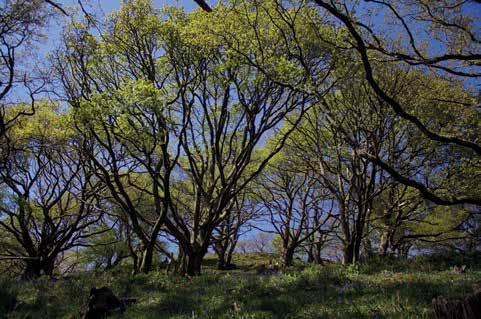
“I think the sector has to acknowledge that COVID has had a massive impact on the expectations and experiences of young people leaving school. It’s a different world and we all have our part to play in supporting them,” Liz said.
“Offering work experience is really, really important so people can get a taste for it. Even if at that point they think ‘no, I never want to work in forestry ever again’, they’ve saved you and themselves time. It’s about giving that young person a chance to see what it’s like working in an office or in a forest environment, rather than permanently nicking the best talent before anybody else
Recent awardees of the Forest Industries Education & Provident Fund (FIEPF) share how they have expanded their skillsets.
Have you ever thought of applying to the FIEPF to help fund a training course you want to go on? Are you a small sawmill or nursery looking to upskill your staff, or wanting to attend a conference? We are happy to accept individual and company applications – you just need to be a Confor member.
There’s a straightforward application form to complete – the Trustees are looking for information not only on the benefits undertaking the training or visit might bring to your career in forestry, but also how this experience can benefit the wider forestry sector as a whole.
Here we share the experiences of a few recent awardees from chainsaw and safe pesticide use to project management and climbing courses.
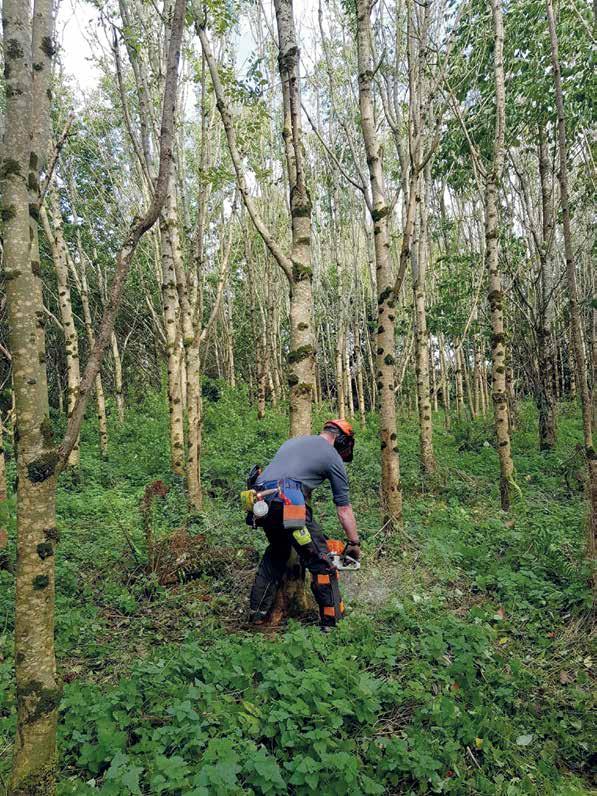
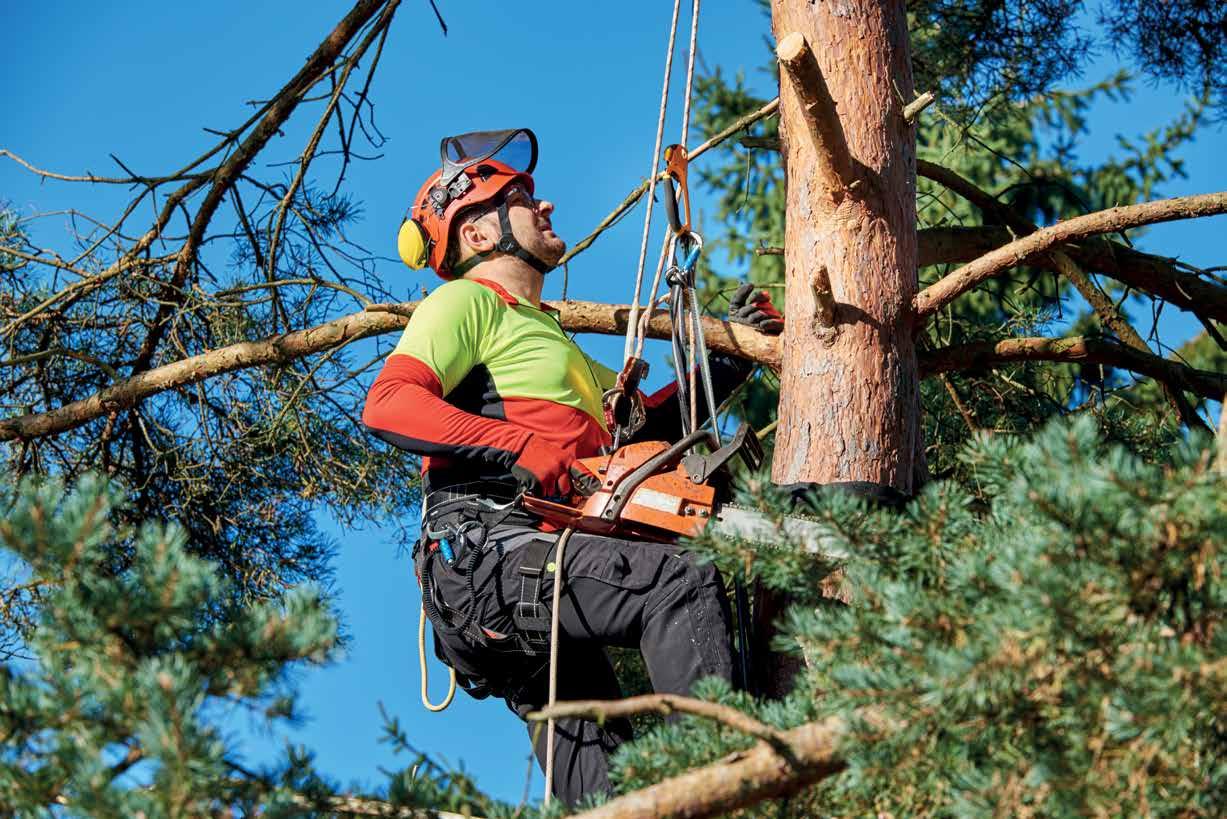
JONATHAN AYERS and HARRY STONE have both recently attended courses on Chainsaw Maintenance and Crosscutting as well as Felling and Processing trees up to 380mm, and noted how grateful they are for the funding.
Jonathan said: “As with learning any new skill, it is important to start with the necessary health and safety. This included risk assessments and emergency procedures and then moved onto the safety features and functions of a chainsaw.
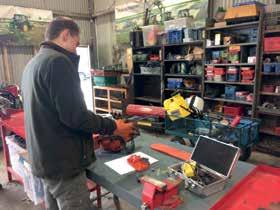
“While diagrams and workbooks are great, I personally find it easier to learn by practical application. In the workshop we went through the necessary maintenance and then moved onto crosscutting in the yard.

“A couple of weeks later, out in the wood, I found it particularly helpful to get out on site promptly and learn by watching, listening, and practicing. Most of the time was spent processing - snedding, crosscutting, stacking, and tidying up.
“Felling is the most enjoyable part so don’t rush it! For the assessment you must fell two trees and hang up one in the process. It is probably the only time I will actually try to hang up a tree, but it allows you to demonstrate how to safely get it down.
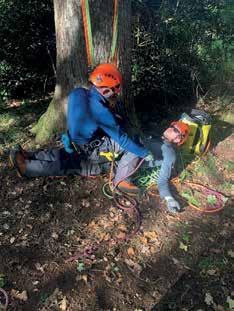
“These courses have given me a thorough understanding of the risks and the safe procedures when using a chainsaw for felling and processing trees up to 380mm. I look forward to building on these skills going forward. I also believe these courses provide crucial knowledge for woodland managers in ensuring the necessary meas-
ures are being taken during forestry operations to provide as safe a work environment as possible.”

Harry added: “The course covered a lot of information on the technical aspects of the saw, giving me confidence in understanding and maintaining my chainsaw. It was very useful to learn how to take everything apart and understand the functions and requirements of all the components inside. I now feel comfortable maintaining and fixing my saw in the woods and at home.
“After completing both courses, I was able to secure an internship at Working Woodlands Cornwall, where I enjoyed my first season of coppice work. Here I picked up some more skills, knowledge and most importantly practice!
“The award has been incredibly helpful to me, as a student with a limited budget, and given me the boost that I needed to get into an industry that I did not think possible a year ago.”
Effective project management, pivotal to GEORGE DENNISON’s role at Sylva Foundation, led him to develop both his knowledge and practical implementation of theory through the Association for Project Management’s series of the Project Professional Qualification.
With support from the Fund, he was able to build on the theoretical foundation laid in previous qualifications and focus on the application of theory into real-world projects through enabling effective leadership and management, governance and oversight, and planning and control.
He feels he can now deploy the processes and tools learnt to deliver transformational projects within the forestry sector through the myForest platform.
WILL DANIEL undertook a Safe use of Pesticides & Knapsack Sprayer course and found it really informative, with plenty of useful booklets and pointers to help with the use of pesticides in the real world. After a thorough assessment, he now adds this ticket to other practical “on the ground” training to improve his employability in the industry.
Brothers JOSHUA and KIERAN HERRON, now working together at Herron’s Tree Solutions after time in nature conservation, attended NPTC Tree Climbing and Aerial Rescue and Cutting courses in order to gain the necessary skills and essential training needed to move their careers in the directions they were hoping for.
Their business is now well underway with the skills they have learnt being put to use on a weekly basis - apart from the aerial rescue, fortunately.
Joshua noted: “Sometimes gaining the skills and tickets required can be slightly out of reach; the funding was relatively straightforward to apply for and we had assistance when it was needed during the process.”
Confor’s Richard Hunter paired up with Scottish Forestry and industry representatives to put potential new forest machine operators to the test.
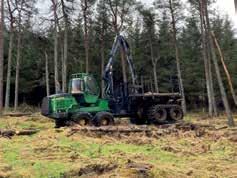

The pathway to becoming a forest machine operator (FMO) can be a difficult one, with limited options to gain experience before committing to it full time. Therefore, following the success of last year’s pilot events, we hosted another round of FMO taster sessions.
We wanted to give as many people as possible a day to try their hand on a simulator, then take the best candidates forward to an on-site experience with a real machine. This resulted in over 80 applications and 70 ultimately attending the first stage events, held at the Scottish School of Forestry (SSF) in Inverness and Battleby Conference Centre in Perth.
Three of the simulators were owned by John Deere, with others supplied by Komatsu, Lantra, and Blacklock Harvesting. All the simulators were loaned for the events as each organisation has spoken about their desire to support new entrants to forestry.

Additionally, the SSF already hosts two simulators that are used by students and taken to schools to encourage children to consider forestry as a career. Though we can’t be sure, we do believe this was the largest concentration of forestry simulators in one room, potentially ever, in the UK!

All the delegates got real first-hand accounts of what life as an FMO is like: the travel, the hours, the conditions, and the pay. It was a no-holds-barred conversation, but there was no point sugar-coating the reality of the job and risking potential new operators walking out further down the line.
There were of course some people that decided FMO wasn’t for them while operating the simulator. One delegate asked ‘does it go faster than this in real life?’ and ‘what
else do you do?’ - he clearly didn’t like the answer and left early.
Those who progressed to a shot with a real machine were hosted by H&W Training at Lamington.
John Williamson give instruction to the delegates on basic machine operation within a woodland setting. The forwarder was a 1510G provided by John Deere, along with everything needed to run it for two weeks. The site was mostly mature Pine cut at 3.7m, so easy handling for the newbies, but those that showed a good degree of proficiently got to move some Sitka Spruce first thinnings cut at 2m for a greater challenge.
Feedback from the delegates was overwhelmingly positive. They showed great interest and commitment in getting involved at both stages, some even having to battle snow to make it.
The events were advertised nationwide, which garnered attention from across the UK and suggests future potential for similar sessions further south. The average age of applicant was 35, and most had a background which included machinery, though there was some interest from completely
different career backgrounds.
Plus, as proof of the positive impact we are having with military leavers, a strong cohort of former Armed Services were in attendance. The simulator event apparently even made standing orders at the Kinloss Barracks and one delegate commented that the forwarder ‘handles better than a tank’.
Although a small number of women attended the simulator sessions, none carried through to the next stage; this was for several reasons, the most common being that becoming an FMO would require a considerable amount of retraining from their current employment.
The event was funded by Scottish Forestry and supported by many across the sector. However without the continued support of the forest industry, most notably John Deere, these events would not take place.
For example, when the snow started to fall and band tracks were needed, they were quickly supplied and fitted by John Deere staff to ensure the delegates didn’t miss out.
Komatsu also had an additional simulator brought over from France for the sessions. This laptop-based version ran the same software as the full seated simulators and clamps directly to a table to be used. This makes it more accessible and easier to transport for similar training events.
If you are looking for new forest machine operators and are interested in training delegates from these events, details will be made available via Confor. Please contact richard.hunter@confor.org.uk to indicate interest. (GDPR rules apply.)



Investing in the workforce through a comprehensive training programme provides multiple benefits, from an industry, company, and individual perspective. Often, people enter the forestry and timber sector either straight from school, through an apprenticeship programme or as a graduate, which can equip them with solid forestry knowledge but a limited set of hands-on skills.
Through education and experience, many will have the skill set required to carry out their day-to-day role. While there is always scope to develop these skills further and continue their learning journey, their experience and capabilities can be enhanced through training above and beyond their job title. Providing the platform and training to provide a greater depth to employees’ skills can only ever be of benefit to
a company, and often to the wider sector as well.
People often talk about the accidental manager as individuals who move upwards through a business with robust hands-on abilities, but they are lacking in some management and leadership skills.


It’s a development area that has been overlooked, not just by our sector but by the wider economy. Certainly, leadership and management are skills which few naturally possess but many would benefit from having a deeper understanding of.
While there can be no denying that investing in this area can bring substantial benefits for a company’s needs and future vision, having more qualified individuals skilled in the art of leadership and management can have a wider influence and positive rewards for our sector as a whole.
That is why BSW Group has been investing in working with the Charted Management Institute (CMI) since 2017, offering level three, five and hopefully soon level seven qualifications to its employees.
Simply put, our sector has an ageing profile. The average median age of someone working in forestry and timber is 48, which means that in a few short years, some of our most experienced and skilled employees will be retiring.
If we don’t act now to provide the necessary training to graduates, managers and even senior managers, we will soon find ourselves in a position where our new leaders don’t have the skills they need, or that we need them to have. While there is no
Leadership and management is also force (not just within our sector) that is disillusioned with work, endorsing ‘quiet quitting’, and undertaking a reassessment of work/life balance in a post-Covid world. There is strong need for managers who are able to provide strategic leadership to get
Now entering our sixth year of training, there is evidence that focusing on this area as part of our career development policy has led to an improvement in productivity by positively impacting morale and motivation among workers - which is especially important in an industry like forestry, where there are many long hours spent working alone outdoors. This type of training has also been shown to improve employee satisfaction and retention rates.
Taking all this into account, there is a compelling case for the need for this type of training, to better prepare for a sustainable future for our ageing industry. It has also provided value for employees. Investing in them builds a sense of trust in them and their capabilities, as well as providing them with the knowledge to work with their team effectively.
There is a strong argument to be made that in order to meet the vision set for the future of the industry, training of this kind will provide a diverse workforce that that meets the demands and aspirations of an ambitious and growing sector. Leadership and Management courses help to inspire and develop ambitious individuals who are committed to helping to make our sector better.

The CMI is a global organisation, operating and recognised in over 170 countries, meaning their course material is exceptional and honed to deliver what is required.
However, as all of us who work in forestry and timber know, our industry presents its own set of challenges that are unique to us. BSW Group is lucky enough to have been able to work with the CMI to develop courses that link more closely with our needs on a granular level.
There is also the benefit of other Chartered bodies within our sector, for example the Institute of Chartered Foresters, recognising the importance of providing opportunities for career development in leadership
and management. Any individuals currently working towards ICF qualifications can reduce the number of units required if they already have CMI qualifications in place.
Even so, we know that not every one of our employees, even within our forestry businesses, will go through the ICF. Instead, offering the necessary training to gain Chartered Manager Status offers an alternative and supporting development model.
Each level of our training programme runs for one year and consists of three units that employees must complete in order to be awarded the relevant certificate. As training is taught internally by a Group Learning & Development Manager, cohorts can access information and help with the assessment process at any time.
Additionally, there is flexibility in the units that can be chosen by a business to ensure that their needs, values and vision are met.
Offering training to all employees who meet the criteria means that many choose to go on to secure Chartered Manager Status (level 5 and above).

Chartered Manager Status from The Chartered Management Institute is a certification that shows you’re qualified in leading teams in business environments. In fact, this qualification is recognised worldwide as one of the most prestigious professional qualifications available today.
Already Regional Managers, Assistant Managers and Administration personnel have been able to take advantage of what we offer and gain Chartered Manager Status.
Now a core policy within the whole BSW Group, we are firmly in the conviction that leadership and management courses have a role to play in the sustainability and viable future of the forestry and timber industries.


In the heart of the Lake District, a small team of chainsaw professionals are working to improve safety and share skills across the spectrum of industry, writes ABA International CEO William Robb.


Managed by internationally qualified assessor Andy Dixon, Chainsaw Training Lake District is an Awarding Body Association (ABA) International accredited centre promoting safe and skilled chainsaw use.
Andy has worked with machinery in the forestry and gamekeeping sector in Cumbria for over 30 years. He states his number one priority is to “provide quality training aimed at preventing accidents and potentially saving lives”.
His first chainsaw was a Homelite, which in the early days did not have a chain brake like modern chainsaws. Andy has a great deal of knowledge and experience in the land-based sector and now feels privileged to be in a position to pass on his expertise to others with an emphasis on health and safety.
Chainsaw Training Lake District continues to evolve, offering a wide range of industry courses and currently has a team
of six experienced trainers and ABA-registered assessors.
ABA International is a non-profit regulated awarding body accrediting nationally delivered qualifications between its centres and partner organisations worldwide. The international education and certification body was established in 2012 with a mission to ‘Reduce Accidents and Fatalities’.
Its Head Office is situated in the Czech Republic, and it has numerous branches distributed globally.
ABA endeavours to improve safety standards, mobility and professional levels of competence across a range of industry sectors, including forestry and arboriculture. ABA’s qualifications are delivered via its network of centres which include universities, colleges, technical schools, vocational education training centres and more.
Assessors like Andy and his team are
industry proficient, comply with an International Code of Conduct, and meet continuing professional development requirements. They ensure quality safety standards are met, and these standards are reviewed regularly by international industry expert groups.
Additionally, with its 24/7 online qualification check, the ‘ABA e-passport’, employers can quickly find out and validate the current status of an operator’s certification. Employers have been very welcoming of this initiative, particularly where they recruit employees from other countries.
For example, the ABA chainsaw skills levels (ground-based and aerial) have been independently mapped against UK levels and evaluated by HSE as at least equivalent to similar UK schemes. This provides employers with a clear benchmark of a potential employee’s skills level.
Chainsaw Training Lake District’s cli-
ents have included agricultural and forestry contractors, machinery manufacturers, fencing contractors, local authorities and estate maintenance teams located anywhere from central England to as far north as Lanarkshire in Scotland.

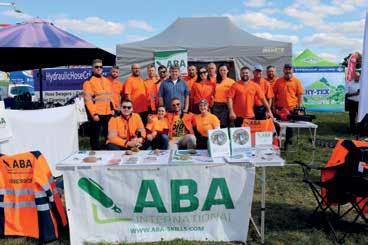
Some of their larger clients have included organisations such as British Nuclear Fuels and Continental Landscapes amongst others.
Andy states that he and his team are “both privileged and fortunate to deliver forestry training in some of the most beautiful parts of the country”.
Andy’s history in the rural sector stretches back generations; for example, his father was the first person to introduce an all-terrain vehicle to Longsleddale for estate and woodland management. This has clearly had an impact on his dedication to delivering high-quality training across the board.
He said: “Due to a strong family history and connections to the farming sector, this is a personal priority sector for safety training as it’s close to my heart and the persistently high accident and fatality rates that continue to occur here are unacceptable.”
For more information visit www.chainsawtraining-lakedistrict.co.uk and www. aba-skills.com.
To coincide with the beginning of the OPM season in March, the Forestry Commission has implemented changes to the three operational boundaries of existing management zones to further help in restricting the spread of the pest.
OPM management varies across England to reflect the known distribution of the species and to protect uninfected areas. A Government programme to manage OPM has been in place since 2012 to control its spread and reduce pest prevalence, undertaken by the Forestry Commission.
As of March 2023, the Established Area in which OPM is established, and the Buffer Zone in which an annual programme of OPM management led by the Forestry Commission takes place, has been updated to limit the expansion of OPM into the rest of the UK, which is designated free from the pest.
Trade and local authorities should check the updated zones and boundaries on GOV.UK and the OPM resource hub to establish which zone they are now in.
Andrew Hoppit, Oak Processionary Moth Project Manager, said: “Oak processionary moth larvae can cause significant damage to oak trees and pose a risk to human and animal health. These new measures are designed to minimise the spread and impact of the pest and pro
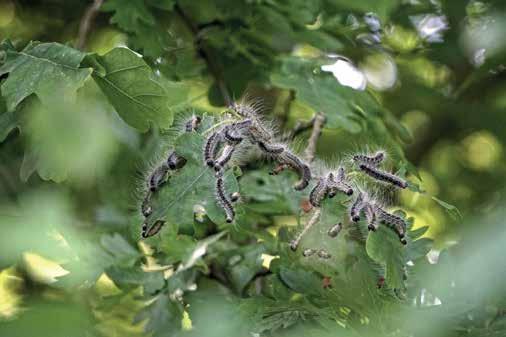
OPM caterpillars and their nests contain hairs which can cause itchy rashes, eye and throat irritations, and should not be touched under any circumstances. They also feed on oak leaves and can increase trees’ vulnerability to attack by other pests and diseases, making them less able to withstand adverse weather conditions, such as drought and floods.
The greatest human and animal health risk period is May to July when the caterpillars emerge and feed before pupating into adult moths.
Later this year, new regulation will come into force that will permit the movement of large oak trees within the OPM Buffer Zone and Established Area, provided specific biosecurity and movement measures are met. Any Professional Operators in the Buffer Zone or Established Area for 2023 should speak to their Plant Health and Seeds Inspector (PHSI) to discuss biosecurity requirements, including what they need to do to prepare.
The OPM Groups Grant funds the surveying of oak trees within local communities in London and the South East, supporting efforts to better understand the risks and appropriate management of OPM.
To ease the administrative process and encourage cooperative action in local communities, it pays for a lead facilitator to form a group of local landowners who all need support to tackle the pest. This builds on existing support and guidance available to help minimise the impact and spread of the pest.
Applications have reopened for the Woods into Management Forestry Innovation Funds and the Tree Production Innovation Fund to further support expansion and management of our nation’s trees.
Delivered by the Forestry Commission, almost £4 million will be allocated to successful applicants across both funds, which together boost nature regeneration efforts, promote biodiversity, and support innovation.
Richard Stanford, Chief Executive, Forestry Commission, said: “Our trees and forests are under threat from climate change, pests and diseases. Trees have to be resilient for the very long term of their lives and we need to innovate to ensure the woods we have, and those we must grow, thrive.

“The projects supported through these funds are essential in supporting efforts to build larger, more diverse and more resilient treescapes across the country and I strongly encourage all suitable projects to apply today.”
This funding aims to bring an additional 20,000 hectares of existing woodland into active management, which can help boost biodiversity and protect against pests and diseases.
The fund will also support projects which will develop new technologies and
Timber Development UK (TDUK) has unveiled a comprehensive Timber Skills Action plan in partnership with the HCI Skills Gateway, aimed at equipping the UK construction industry with the necessary skills to increase the use of timber and achieve net zero targets.
With the construction industry responsible for almost 40% of global emissions, and half of all materials extracted from the environment, experts have identified the use of timber as a key solution to significantly reduce carbon emissions.
ber production meet domestic and inter national demand. This will bolster timber security and grow the UK’s forestry and primary wood processing sectors.
Funding under the second round of the Woods into Management Forestry Innovation Fund helped to support the Northwoods Innovation Programme, managed by Northumberland-based low carbon heat and forestry consultancy, Reheat.
Engineered products like Cross-Laminated Timber can capture and store carbon in the built environment, resulting in a net benefit of 754CO2/m2 reduction compared to other forms of construction.
The Timber Skills Action Plan provides an industry-agreed breakdown of the skills and knowledge required for building with timber. This will aid the development of training programmes and support Continuing Professional Development progression, enabling built environment professionals to confidently incorporate timber into building designs.
David Hopkins, Chief Executive of TDUK, said: “Our ambition is to support every built environment professional to identify and address timber skills and knowledge gaps so the industry can make the best use of timber in construction.
“The construction industry faces a steep climb to achieve net zero targets as one of the worst-performing industries. Timber provides a ready-made solution that doesn’t rely on greenwashing, specu-
Following the success of their Woodland Management Focus Area Pilot (WMFAP), the project consortium has expanded to include Timber Auctions and Green Business Finance with the aim of developing a wider programme to overcome specific barriers to woodland management.
The funding has also led to the relaunch of Northwoods, a woodland initiative, with the long term aim that Northwoods can once again deliver a range of projects to
lative innovations, or progress in other industries to deliver genuine carbon savings in the short and medium term. We now need the construction sector and government to hear this call to action.”
The Action Plan is the work of a coalition across industry, academia, and funders, creating a competency framework that underpins a set of short, practical courses already developed by NMITE’s Centre for Advanced Timber Technology.
Kirsty Connell-Skinner, Programme Manager at the HCI Skills Gateway, said: “This plan, led by HCI Skills Gateway using Scotland’s best practice, is an important step in the development of the UK-wide timber construction trade, as it allows us to set a national mission for the industry.
“The four UK nations have achieved different standards and progress within the sector, but this action plan has been built on the best practice, learning and thorough research by a strong group of partners, and serves as a collaborative way of moving forward.”
support the forestry sector with its various challenges.

The closing date for the Woods into Management Forestry Innovation Funds is Monday 15 May.
As tree planting across the country increases, the Tree Production Innovation Fund will support the development and deployment of new technologies and ways of working to provide a diverse supply of healthy young trees. This will support Government ambitions to increase tree planting rates.
The Tree Production Innovation fund has previously facilitated a project developing a natural alternative to man-made fertiliser: Woodland Grow, an innovative peat-free woodland-based compost made from an organic mix of materials that mimic woodland soils. It has been designed to increase tree production, plant health, growth rates and reduce our carbon footprint.
The project team has developed a newgeneration compost free of peat and synthetic fertilisers and that is suitable for both professional growers and amateurs alike.
This collaboration brings together SAF Woodland Management and A.W. Jenkinson Forest Products, with support from Euroforest, Prior & Rickett, FERA Science and Soil Ecology Lab.
The closing date for the Tree Production Innovation Fund is Tuesday 9 May.
Forestry Commission are hosting webinars to support with the application process for both funds. To register for a webinar, get further information about the funds and apply, visit https://bit.ly/3lw4qCJ.

The ICF’s National Conference 2023, Connecting Trees, Farmers and Foresters, will encourage rural sector stakeholders to have a frank, honest and engaged discussion about the integration of trees into farming and foster a mutually beneficial relationship between forestry and farming.
For speaker Nikki Yoxall, farmer and Head of Research for Pasture For Life, silvopasture was the “saving grace” when she and her husband started building a farming enterprise. She hopes the conference will galvanise policy makers into streamlining the tree planting process.
She said: “The discourse is changing. Historically, there has been an either-or approach, but people are realising the additional benefits trees bring to livestock and I think farmers are recognising they can have the best of both worlds.
“However, the policy landscape remains one or the other. Existing schemes are all far too dense and that puts farmers off, understandably unwilling to lose productive land. There is a middle ground but there is limited infrastructure or support and often farmers have to carry the burden financially for agroforestry schemes.”
A previous Scotland’s Finest Woods winner, Nikki added that it’s important to bring farmers and foresters together to share localised knowledge, from different growth pat-
terns and potential problems to benefits such as increases in biodiversity.
Louise Simpson, Executive Director of the ICF, said: “Farmers and foresters are often portrayed in opposition. However, we are only going to reach climate change targets if we work together. We hope this ground-breaking conference will promote partnership and collaboration between the sectors.
“This is not about foresters talking at farmers and telling them what to do; we want to stimulate an honest and frank debate. Farming and forestry are both vital, from the food we eat to the clothes that keep us warm and the homes we live in, as well as flood prevention, increases in biodiversity and climate change mitigation.”
The conference will be held at Edgbaston Stadium on 25 and 26 April, with online tickets also available for those unable to attend in person. It will be chaired by Sir Harry Studholme, former Chairman of the Forestry Commission.
He commented: “Farmers have fair questions about planting, some cultural, on how the landscape looks and how communities might change, some economic around productivity, and how we fund jobs to keep our landscape alive.
“At the same time, farming is changing fast. The Common Agricultural Policy is unwinding, trade barriers melting away and environmental responsibilities increasing. With these changes comes pressure on businesses. Forestry can help but to do so foresters and farmers must work together - this conference will explore how building better connections can benefit both.”
Whilst it would be pleasing to be able to report that the sawn timber market has picked up and that we are expecting a strong year of sales, I would be deluding myself and you if I made this statement.
At the start of March, sawn timber sales had yet to see any improvement since the end of 2022. Indeed, even parity with prices through the second half of 2022 would be a positive. So why is this?


Fundamentally the underlying issue in the market remains a lack of activity since the end of 2021. The sawn market has largely been in the doldrums with demand for construction products being oversupplied through a combination of both imported and home-grown product.
In Central Europe, construction timber price has reached such a low point while delivered sawlog prices strengthen (due to availability issues) that there are reports of sawmills running at reduced throughput, and they are making little-tono margin on their activity.
Following this trend, sawmills in Britain are also running at reduced throughput levels - typically between two-thirds and three-quarters of their normal run rate.
Perhaps one area of good cheer for growers is a reduction in the availabil-
ity of standing sales, and therefore logs, from the state sector in both Scotland and Wales due to capacity and planning issues. It is anticipated that in both markets the respective state bodies are unlikely to meet their published long-term sales targets for 2023 or 2024.

At the same time, some of the parcels previously purchased at the height of the market are proving uneconomic to work for the purchasers due to falls in log price, or in some instances due to the cessation of sawing by the intended market, which is further delaying the harvesting.
Therefore, there may be localised shortages of parcels and some end users have anticipated this within their purchasing strategy resulting in increases in prices paid for standing parcels.
The crystal ball does not reach out far at the best of times and it is hard to see what will change over the second, or even third, quarter of 2023. Whilst the usual spring increase in demand for fencing undoubtedly will happen, we are not expecting it to be anything other than the normal uptick in activity and much of the demand generated will already be in the sawmills stock yard or sitting in your local fencing merchant.
Other segments of the sawn market are performing better with demand for pallet and packaging at a reasonable level which is propping up the activity of some operators.
Small roundwood demand remains reasonable though not as strong as at the start of winter. Most users are reported to have decent volumes available to purchase at the ‘right price’.
The end of last year saw small roundwood prices and sawlog prices almost reaching parity as log prices fell and demand for small roundwood peaked. This trend has now reversed, and a gap is opening up between the two products. Though not at the dizzy heights seen in 2021, the trend is welcomed and underpins good value for standing parcels when compared to the medium-term trend.
“THE CRYSTAL BALL DOES NOT REACH OUT FAR AT THE BEST OF TIMES AND IT IS HARD TO SEE WHAT WILL CHANGE OVER THE SECOND, OR EVEN THIRD, QUARTER OF 2023.”







Turbulence from macro-economic factors has affected many sectors in the last 12 months, and forestry has not been immune. The economy is fragile, with little to no growth, and we certainly live in uncertain times. Unsurprisingly, forestry investors are being more selective and cautious, particularly when it comes to planting land.
Nevertheless, forestry remains attractive with its inflation beating reputation, and plantation prices are generally holding firm.
Analysis of the commercial forestry market in the John Clegg & Co Forest Market Review 2022 shows that £219m worth of plantations were traded in the 2022 calendar year, compared with £199m in 2021.
However, there are signs that significant global events have started to introduce a little more caution into the marketplace than in recent years. Average plantation prices were down on the previous year, although it is important to note that 2021
was a particularly extraordinary year for the sector when supply was tight, and a small number of exceptional properties sold for very high values.
Sales activity slowed in late 2022 as concerns over macro-economic factors brought uncertainty to consumers and a drop in timber prices. Whilst those macro-economic factors remain, they appear to have been “factored in” to consumer’s thoughts on the economy, and cautious optimism is returning to parts of the woodland sales market.

Mortgage rates that appear to be peaking at c.6% have provided some reassurance that the predicted economic woes are not as deep or as long lasting as were originally forecasted.
Prices for the small (< 3 acre) woodlands remain resilient, at an average price point of c. £15,000/acre (£37,000/ha), but with significant variation. This is sufficient
to appeal to first time buyers and those looking for an amenity wood in which to relax and enjoy.
Woodlands that are “mid-range” in size or price are attracting interest. Properties that we have had on the market in mid Wales and England are under offer at prices that are close to, or just exceed, the guide price. The legal processes that now follow can take around 4-5 months until the sale formally completes, so more information will be available on those sales in the late summer.
The sales of larger commercial woodlands continues, albeit a lower number than previous years, and with prices keenly observed and depending upon key criteria, such as access and Yield Class. The large (145ha, average age 17 years) productive Sitka dominated Bryn Forest in Ceredigion had a guide of £5.5m (£38,000/ha, £15,300/acre) and is under offer. Meanwhile further north in Yorkshire, Raydale Forest (average 29 years old) had a guide of £3.5million (£21,000/ha, £8,520/ acre) and is also under offer.

As economic confidence starts to return, we expect more, larger woodlands to come on to the market, although numbers will be smaller than last year, and prices will reflect the current economic conditions, and will be more measured than before.
There continued to be a small number of examples of very high prices for large, young, second rotation woodlands. These sales are characterised by very high growth rates, good infrastructure and easy access to markets. Prices ranging from £3550,000/stocked hectare have been paid. Care needs to be taken when drawing comparison to less attrac-
Two attractive, sub million pound properties (Tinto End Two and Greenhills in South Lanarkshire) were put to the market in Autumn 2022 and found buyers quickly at good prices. Relatively high Yield Class and planted in 1987, they sold for between £35-40,000/stocked ha. Meanwhile, Newnoth in Aber-
continued on p45











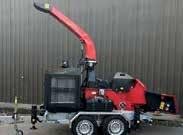

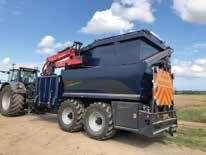


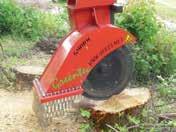

continued from p42
deenshire, of a similar age, sold for some £13,000/ha. This reason for the variation in price comes down to the all-important Yield Class, access and location.
Lower timber prices have clearly im pacted on the value of more mature wood lands where felling is imminent. However, buyers are still seeing scope for rising long term timber prices and are factoring that into calculations. We think there is a good level of buying power, it is just being a bit more cautious than in the recent past.
Planting land has seen a significant drop off in prices in the last six months. Tilhill reported values of £17,000/plantable ha in the year to September 2022, up from £9,000 in 2021 and £6,000 in 2020. Recent evidence suggests we may have gone back to 2021 levels. We are yet to see where the market will settle, but evidence of prop erties caught in this downward transition such as Lochurd in the Scottish Borders and Cromlix Hill in Perthshire indicate that demand has softened.
Changes behind this trend can be linked to two principal factors: changes to the eli gibility for carbon credits and higher inter est rates.
Commercial conifer schemes are now effectively excluded from eligibility for the Woodland Carbon Code. If investors were assuming say 200 tonnes CO2/ha at say £15/t, that alone knocks values back by £3,000/ha.
The natural capital/carbon market remains strong with a variety of buyers looking at native woodland and peat restoration as a means of delivering carbon credits. This market has been evolving over the last two years and there is still some uncertainty on pricing, with agents invariably inviting offers rather than having the confidence to set a guide price.
Big estates are changing hands, such as Invergeldie in Perthshire, bought by a charity, totalling some 4,700ha with plans to plant in the region of 2,000ha, plus extensive peatland restoration.

In summary, there is more caution in the market than for many years. Lower timber prices, higher interest rates and inflation all mean buyers are being more selective. However, there is still a lot of capital interested in forestry investment and activity levels remain high.
Wider market and political uncertainties persist and, as ever, landowners and investors would be prudent to take advice in order to capitalise on the opportunities that undoubtedly exist in the current market.
If you are contemplating either a sale or a purchase of forestry in 2023, please contact us for a confidential discussion.
John Clegg & Co have specialised in the forestry and woodland market for over 50 years and are one of the leading agents in the UK, selling, acquiring and valuing hundreds of woodlands each year.
Following a successful first year, in which more than 80 expressions of interest were received, Defra has worked with Forest Research to evaluate user feedback and make several key changes to the Tree Health Pilot.
These include simplifying the payments process, introducing higher payment rates, implementing a new advice package, and improving guidance.
The innovative scheme, running between 2021 and 2024, provides land managers with grants, guidance and advice to reduce the impacts of tree pests and diseases and build the resilience of England’s trees, woodlands and forests ahead of the roll-out of a future nationwide Tree Health Scheme.
In line with changes being made across the Countryside Stewardship and the England Woodland Creation Offer schemes, payment rates for standard capital cost items - which are one-off projects such as installing deer fencing and tree shelters – are increasing.
Maintenance rates, which help ensure newly planted trees are growing healthily, will increase from £300 to £350 per hectare per year for trees planted in woodland. And to help cover coordination costs for group applications, the fee paid to the group facilitator will rise to
£24 per hour.
Chief Plant Health Officer Nicola Spence said: “This Pilot supports land managers to deal quickly and effectively with tree health issues. By funding innovative methods to fell and restock diseased trees, for instance, using skylines or horse loggers to reach larch trees in remote areas, and encouraging group collaboration to deal more efficiently with roadside ash – it ensures a comprehensive and targeted approach to better protecting our trees.
“We have been able to gather meaningful feedback for the design of our future Tree Health Scheme, with a greater focus on tailoring support to land managers where most needed and equipping them with practical tools to reduce and manage future threats in order to create more resilient treescapes.
Forestry Commission Chair, Sir William Worsley, added: “These improvements will ensure greater participation in the scheme, better knowledge of the issues around tree health, and swifter action to tackle pests and diseases – all helping to protect our trees now and for future generations.”
The Pilot is currently available in London, the South East, the North West and the West Midlands.
examines how a new bill may
The UK rural sector often leans on casual or agency workers during the year to sustain seasonal requirements, with a need for a flexible workforce and diverse expertise.
The UK government has now issued The Workers (Predictable Terms and Conditions) Bill, which proposes to give eligible workers a statutory right to request a more predictable working pattern. Importantly, the Bill only provides a right to ask for a more predictable working pattern, not an automatic right to a predictable working pattern itself.

Nevertheless, this could appeal to rural workers who do not have control or certainty over the shift patterns that they work.
Eligible workers, not just employees, will have the right to make a request where:
• There is a lack of predictability regarding their work pattern;
• The change relates to their work pattern; and
• Their purpose in applying for the change is to get a more predictable work pattern. In order to make a request, a worker will need to have a prescribed level of service with their employer. The qualifying criteria in this respect has not yet been confirmed, but it is expected that a worker will need to have a minimum of 26 weeks’ service at the point of making the application. A worker can make two applications in any 12-month period.
There is no definition of ‘predictability’ in the Bill. It does, however, state that workers on a fixed term contract of 12 months or less may request that the term is extended or becomes permanent. Other than that, it seems that a ‘lack of predictability’ will cover any worker whose hours or days vary in a way which provides them with uncertainty. For example:
• Casual / zero hours workers without guaranteed hours;
• Annualised hours workers if the employer has discretion over the working pattern;
• Workers whose hours are determined by unpredictable shift patterns or rotas.
The Bill contains a similar set of rights for agency workers. In this context an agency worker may be able to apply to a temporary work agency for a more predictable working pattern, in cases where they have had a contract with the agency at some point in the month immediately before a ‘prescribed period’ (to be confirmed).
If the agency worker has worked for a hirer in the same role continuously for 12 weeks (within a period to be set out in regulations) they may also be able to apply to the hirer for a contract of employment, or other workers’ contract, which has a more predictable working pattern.
Similar to the existing flexible working regime, an employer is not obliged to agree to a request, but they must deal with the application reasonably and respond within one month. An employer can only reject
continued on p48

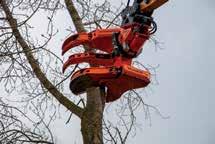









continued from p46
an application for one or more of the specified reasons:
• Burden of additional costs;
• Detrimental effect on ability to meet customer demand;
• Detrimental impact on recruitment;
• Detrimental impact on other aspects of the employer’s business;
• Insufficiency of work during the periods the worker proposes to work;
• Planned structural changes.
If the worker’s contract terminates during the one month ‘decision period’, the employer will still be obliged to respond to the request. However, it would be able to rely on additional grounds for refusing the request, e.g. the employer dismissed the worker fairly, or the worker resigned.
A worker can bring an employment tribunal claim if an employer fails to follow the above requirements. If successful, an order for reconsideration of the request or compensation could result. The amount of compensation will be set by regulations and may be limited to 8 weeks’ capped pay as it is under the flexible working regime.
There is no timetable for implementation, and some of the detail of how the right to request will operate in practice still has to be set out in separate regulations. The new right will have the most impact in sectors where the use of casual workers and changeable shift patterns and rotas is widespread, and on businesses using short fixed-term contracts or agency workers. If your organisation engages individuals on unpredictable working patterns, then you will need to establish policies and procedures to deal with requests.
Confor Members have access to a free legal helpline, administered by Brodies LLP. Get in touch for guidance on key issues that impact forest owners and the forestry sector.
Whether your query is employment law, health & safety, planning, tax or property-related, one of our experts will be happy to give you a free initial consultation. More info: https://bit. ly/3yPGRI1
For members based anywhere in the UK Brodies LLP 0131 228 3777
www.brodies.com
confor@brodies.com
For members based in England/Wales
Atkinson Ritson Solicitors 01228 525221
www.atkinsonritson.co.uk
info@atkinsonritson.co.uk
KILN Services has been designing and manufacturing timber-drying kilns from its base in Essex for over 45 years. The company provides drying and heat-treatment kilns for all sectors of the industry, including softwood and hardwood sawmills, pallet manufacturing, fence-post producers, biomass fuel producers, modified timber and research facilities in universities and training colleges.

In recent years, the market for kilns to dry biomass fuel has increased considerably. This has been driven by consumer awareness of product moisture and government initiatives to improve air quality, such as the Woodsure Ready to Burn accreditation scheme.

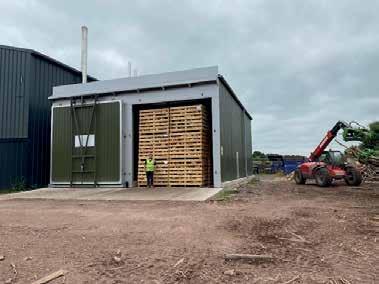
Landowners or contractors looking to plant trees and shrubs in the vicinity of high-pressure pipelines should be aware of best practice guidelines. Phil Taylor, Chair of UKOPA’s Infringement Working Group, outlines some good practice guidelines.
Plant and tree roots can cause damage to the coatings used to protect pipelines and ultimately the pipeline itself. To not only protect the UK’s pipeline network but also to ensure operatives and the environment are safe from incidents, awareness and consideration of how planting and maintenance work may impact these pipelines is essential.
The United Kingdom Onshore Pipeline Operators’ Association (UKOPA) is the authoritative industry body behind some of Britain’s most essential energy infrastructure. Overseeing a network of more than 27,000km of pipelines operated by UKOPA members, the organisation helps ensure the safe and efficient distribution of gas, oil and chemicals through the pipelines to strategic points across the country.
Protecting and maintaining these pipelines is vital to the UK’s economy, so UKOPA works with a wide range of stakeholders to ensure they are aware of the pipelines and the actions needed to be taken if working in their close vicinity (typically within 50m of the pipeline). Key activities where good practices must be followed include planting trees, clearing ditches and erecting
ruts on softer ground, both of which can induce stresses in the pipeline. Before operating heavy machinery in the vicinity of the pipeline, contact the pipeline operator who will advise on the safest course of action.
If planting any new trees or shrubs in the pipeline’s wayleave/easement, written permission should be obtained from the pipeline operator. Any approval granted by the pipeline operator is likely to include retaining the rights to remove, at any point in the future, all trees which might become a risk to the pipeline and its integrity.
The following should act as general guidance for tree planting, based from the centre line of the pipeline.
• Shallow rooting hedges and ground plants (e.g. blackthorn, broom, elder, hazel, etc) may be planted, if necessary, directly across the pipeline.
• Fruit trees, such as dwarf apple stocks, may be planted within up to 3 metres of the pipeline.
• Christmas trees may be planted within up to 3 metres of the pipeline on the strict understanding that these are clear-felled at intervals not exceeding 7 years.
• The following trees (and those of a simi-
• Within 6-10 metres they may be planted as individual specimens or as a single row.
• Dense mass planting may be carried out at distances of greater than 10 metres.
• Poplar and willow trees should not be planted within 10 metres of the pipeline.
UKOPA’s members that operate the pipelines are on hand to help and support landowners, or those working on their behalf, with any questions they may have. If there is any doubt about planting trees or if you are proposing to fell trees or remove shrubs within 50m of the high-pressure pipelines, landowners should contact a member of the pipeline operator’s team who will be able to provide further help.
In addition to tree planting, the UKOPA website has published guidelines and videos showing how to help keep people and the environment safe if working in the vicinity of pipelines, whether erecting fencing, clearing ditches or undertaking excavation work near to the pipelines.
The buried pipelines operate at high pressure, up to 100 Bar (which is equivalent to 50 times that of a car tyre) and may often be found at less than the nominal depth of one metre, in particular where there are natural depressions in the ground, or at drainage ditches and water courses. Due to the flammable and potentially hazardous nature of the products contained, anyone undertaking works near to a pipeline needs to be aware of the potential dangers, what to do, and who to contact before commencing works.
Contacting the pipeline operator and seeking advice will reduce the risk of a serious incident, environmental damage, or potential fines for the landowner or contractor.

To ensure the best and safest outcomes, anyone looking to undertake works close to a buried pipeline should:
• Give the pipeline operators a minimum of seven days’ notice before works begin to ensure they are available to support the proposed activities.
• Never assume consent is given - works should not begin until permission is granted.
• Be aware that pipeline depths vary; they are often found only a metre below the surface and are not always protected with slabs.
continued on p50
continued from p49
• Pipelines do not always run in straight lines between marker posts. Pipeline operators are there to help mark out the exact location.
• It’s the landowner’s responsibility to ensure that contractors operating on their land comply with regulations.

If there is any doubt about the location of a pipeline or what can or can’t be done in its vicinity, contact the pipeline operator or visit Line Search at https://lsbud.co.uk. By working together, we can ensure there is no accidental damage to life, livelihoods or the environment.
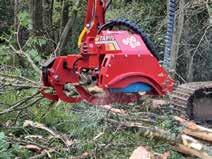
Further information can be found at www.ukopa.co.uk.
Scan the QR code above for a full Good Practice Guide for anyone who may want to plant trees and shrubs in the vicinity of high pressure (HP) pipelines.



Deer numbers in South Uist have made headlines in recent weeks as a petition calling for a widespread cull was signed by close to 200 residents of the community-owned estate.
A key motivator behind the debate was the prevalence of Lyme disease on the island, which is amongst the worst affected in the Western Isles. There were also complaints about woodland damage and grazing on croft land.
Stòras Uibhist, the company which handles the day-to-day responsibilities of the South Uist Estate, acknowledged that red deer numbers – believed to be 1,200 across the 93,000 acre site – were too high but pushed for targeted culls in place of total eradication.
During the recent winter months, 166 hinds, 53 calves and 97 stags were shot in an effort to control the population,
and plans are in place to repeat those numbers each year.
A referendum on 20 March resulted in a vote of 379-140 to save the animals.
Reacting to the vote, Scottish Gamekeepers Association (SGA) Chairman Alex Hogg said: “As the body representing SGA members and their families, who would have paid the price of deer eradication with their jobs, we are relieved for them at the outcome.
“The gamekeeping team have carried out a record reduction cull this winter, in difficult and uncertain circumstances. They deserve credit for that. It was pleasing to hear Storas Uibhist also allude to the other work professional gamekeepers carry out; work which is of benefit to the wider community but is not always reflected solely in balance sheets.”
We are situated in the beautiful county of Northumberland and supply around 15 million bareroot conifer and broadleaf trees per year to a wide customer base. A Plant Healthy accredited grower of major native timber and woodland species including improved Sitka Spruce. Trees can be pre -treated against Pine Weevil if required.

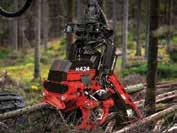


Our team have over 200 collective years experience in growing and nursery production as well as a firm understanding of the forestry industry. Our cold storage facilities ensure our trees are stored at the optimum temperature until you need them. Please get in touch today. No query is too big or small.
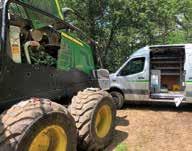
TreesPlease Ltd, Dilston Haugh Farm, Corbridge, Northumberland NE45 5QY 01434 633049 sales@treesplease.co.uk www.treesplease.co.uk


Brampton Valley Training & Assessments is a subdivision of Brampton Valley Group LTD, and specialise in forestry, arboriculture, tree surgery plus other landbased training. As a leading City & Guilds (NPTC) and LANTRA Approved Centre we are able to offer a wide range of industry recognised qualifications. Our experienced and knowledgeable staff are on hand to offer our customers professional and up-to-date advice on all industry recognised training requirements.
Assessments is a sub-division of Brampton Valley forestry, arboriculture, tree surgery plus other leading City & Guilds (NPTC) and LANTRA Approved wide range of industry recognised qualifications. knowledgeable staff are on hand to offer our customers advice on all industry recognised training
south Northamptonshire where we have a dedicated, workshop facility as well as access to 200 acres of stunning wealth of fantastic trees to climb.
Lantra Awards qualifications, we are able to offer a can be tailored to suit our customers’ requirements. using only qualified instructors who have years of Our instructors not only train you to be successful their many years of knowledge, experience and skills arboriculture, forestry, agriculture or horticulture.
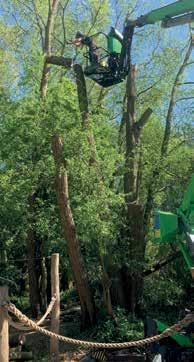
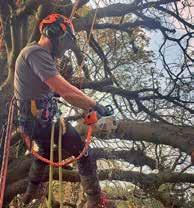
Courses on offer at Brampton Valley Training & Assessments
Forestry & Arboriculture
- Chainsaw ground based qualification
- Chainsaw aerial based qualifications
Forestry & Arboriculture
Our Training Centre is situated in south Northamptonshire where we have a dedicated, fully equipped classroom and workshop facility as well as access to 200 acres of stunning woodland to manage together with a wealth of fantastic trees to climb.
- Stump Grinder
- Chainsaw ground based qualification

- Brushwood Chipper
- Brush Cutter
- Chainsaw aerial based qualifications
- Powered Pole Pruners
- Stump Grinder
- Utility Arboriculture
- Basic Tree Inspection
- Brushwood Chipper
- LOLER
- Brush Cutter
- Forest machinery operations (FMO)
- Powered Pole Pruners
Pesticides
- Utility Arboriculture
- Pesticide Applications
- Basic Tree Inspection
In addition to the City & Guilds and Lantra Awards qualifications, we are able to offer a wide range of bespoke training which can be tailored to suit our customers’ requirements. We aim to deliver these courses by using only qualified instructors who have years of industry experience and knowledge. Our instructors not only train you to be successful in your assessment, but also pass on their many years of knowledge, experience and skills in their chosen subject whether it is arboriculture, forestry, agriculture or horticulture.
- Vertebrate Pest Control
- LOLER
Machinery
If you cannot see the course you are looking for, please telephone
Pesticides
- ATV
- Forest machinery operations (FMO)
- Mobile Elevated Work Platforms
- Mowers
- Remote control machinery
- Digger operations
- Pesticide Applications
First Aid
- Vertebrate Pest Control
- Emergency First Aid at Work
Machinery
- ATV
For more information about the services at Brampton Valley Training please get in touch:
T: 01327 831299
E: info@bramptonvalleygroup.co.uk www.bramptonvalleygroup.co.uk
01327 831299 to discuss your individual requirements
- Emergency First Aid at Work + F
- First Aid at Work - 3 days
ELCAS APPROVED TRAINING AVAILABLE
- Mobile Elevated Work Platforms
- Mowers
- Remote control machinery
- Digger operations
First Aid
- Emergency First Aid at Work
- Emergency First Aid at Work + F
- First Aid at Work - 3 days
ELCAS APPROVED TRAINING AVAILABLE
www.bramptonvalleygroup.co.ukwww.bramptonvalleygroup.co.uk
Should you engage a contractor directly, you are taking on the role of Forest Works Manager (FWM). If you are not sufficiently competent or wellresourced to do all that this entails, you should engage a competent person to do it for you.
Similarly, if your contractor offers to step up and fulfil the duties and responsibilities of the FWM as well, you must check that they are competent to do so.
‘Competence’ is determined as an appropriate mix of resources including quali-
fications, knowledge, skills, and experience. The FWM should be able to demonstrate, for example:
Knowledge
• Health and safety qualifications (e.g. NEBOSH) or access to competent health and safety advice.
• Qualifications in forestry.
• Chartered status.
Skills
• Appropriate training, e.g. IOSH Managing Safely, FISA FWM training.
• Technical training in forestry work and
contract management.
• Effective procedures for selecting and managing competent contractors.
Experience
• Verifiable references.
• Examples of managing and performing similar types of work over time.
The FWM is pivotal in ensuring safety, health and welfare standards are established, implemented, and maintained. The aim is to protect all site personnel, along with others who may be affected by the work like third-party visitors or members of the public.
Generally, if you are employing the services of a forestry business (e.g. a timber purchaser, forestry agent or management company), they will take on the role of FWM and assign an experienced employee or other competent person to do what is required.
The competency framework

FISA have published a framework (https://bit.ly/3ndXpqB) which lays out the core areas of Health & Safety Competence required for those with FWM responsibilities and supports the role as defined in the FISA Guidance on Managing Health and Safety in Forestry (GMHSF) document.
It is essential that those fulfilling the role of the FWM be competent to do so. This includes identifying limitations within organisations and individuals, and recognising when it is necessary to acquire competent assistance.
The framework outlines the main areas of responsibility held by the FWM, along with emphasising the essential skill of effective leadership. This will help towards a ‘safety first’ culture on a worksite where each and every person feels they can make a positive contribution to improving working practices and the health of all those engaged in the operations.
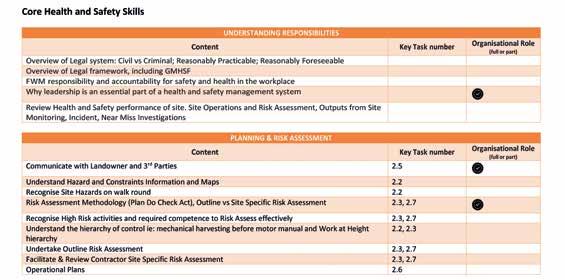
The absence of strong leadership is often at the root cause of unsafe work practices.
Records of continuing professional development (CPD)
should also be documented and maintained. Many organisations will have their own systems for doing this, but a simple template is provided in the framework.

An apprenticeship standard for FWMs would formalise the requirements of the role by describing the knowledge, skills, and behaviours necessary to carry it out. FISA is seeking feedback on behalf of the Forestry Commission in this area, and we are keen to hear from professionals in the industry.
Such a standard would allow the role to be formally recognised (and therefore rewarded) as well as standardising the learning achievements and workplace responsibilities typically required at that level.

It would also provide a progression route for competent craftspeople wishing to progress their careers, and would represent a stepping stone towards professional forester status for those wishing to devel-
The Department for Transport has launched a consultation on proposed reforms to the Driver Certificate of Professional Competence (DCPC) qualification.
This follows the review into DCPC which took place between November 2021 and January 2022 in response to acute driver shortages in the road haulage and passenger transport industries.
op their careers that far.
Under current apprenticeship programmes, the academic learning is delivered off-the-job and makes up 20% of requirements, with the other 80% spent consolidating learning in the workplace. This approach allows current workers to undertake the apprenticeship while remaining in employment. Additionally, there is no maximum age restriction on an apprenticeship programme.
If you have any comments on the potential of a FWM apprenticeship standard, please send them to info@ukfisa.com and we will share your views with the Acting Head of Green Economy & Skills.
The DfT are seeking views on options for how the DCPC qualification is maintained and, in the case of returning drivers, regained, taking advantage of the greater autonomy to regulate following EU-exit. Proposals on which DfT are consulting will require amendments to legislation. Potential measures being considered include:
• Reducing minimum course lengths to enhance flexibility of delivering periodic training,
• The option of new periodic tests as an alternative to periodic training, which will be delivered by the Driver and Vehicle Standards Agency (DVSA).
• An accelerated route for former drivers to return to the sector more easily.

If these changes are implemented, they will only apply to drivers completing journeys within Great Britain, and Northern Ireland if authorities there agree, as DCPC is a devolved matter.
The Timber Transport Forum is considering a response to the consultation and ask that any comments you may have on the reforms be submitted to Paul Boobyer (paul.boobyer@confor. org.uk) by Friday 7 April.
The closing date for the consultation is 11:45pm on Thursday 27 April.
A Scottish School of Forestry graduate has been recognised with an award from Tilhill for woodland creation plan.
Dr Leila Eadie, Forestry HND graduate, has been awarded a specially carved wooden trophy and £250 in prize money for a report she prepared on
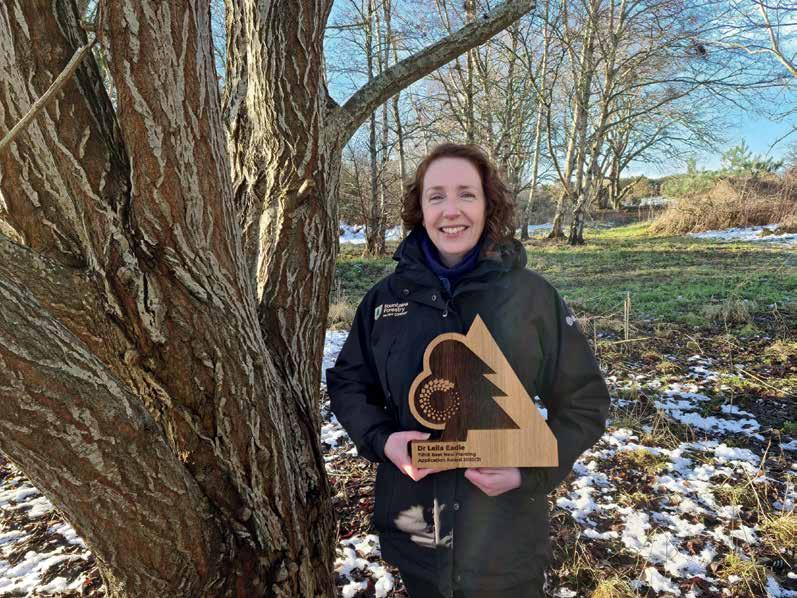
woodland creation as part of her course.
She won the Tilhill Award for Best New Planting Application, which is among a number of annual awards given out by the company to top performing students on forestry-related university courses across the UK.
Leila, now working as GIS & Technology Manager at Fountains Forestry, said: “I am delighted to receive the Tilhill award for ‘Best New Planting Application.’ I de-
AGeographical Information System (GIS) designed for woodland owners and managers has undergone a significant upgrade to provide users with new functionality, in a technological boost to making woodland management and planning more streamlined.
myForest, a flagship project from the Sylva Foundation, is a platform designed to help its users along the journey of creating and managing forests, supporting land managers through regulation and good practice.
In its most recent development, as
part of the Northwoods Innovation Programme, users now have the ability to create and download geospatial PDF maps for use in the field with third party mobile technology.

The upgrade gives woodland owners and agents the opportunity to download their mapped compartments, sub-compartments, and features, as well as assess their live location. This means myForest users will be able to carry out their work more efficiently, reducing the need for specialist knowledge while incorporating these mapping practices into their every-
cided to study forestry because I wanted to change careers from my previous job as an academic researcher.
“Living in the Scottish Highlands, you see forestry all around and this stirred my interest in finding out more about the cycle of timber production.
“The course at the Scottish School of Forestry was excellent, taught by lecturers
day creation and management processes.
George Dennison, myForest Manager, said: “The myForest Team is thrilled to have launched this cutting-edge functionality, enabling users to take the work they’ve done in myForest out into the field with them. It is also hoped that with the ability to download geospatial maps from myForest, landowners and agents will now be better placed to work with contractors on-site, providing all parties with greater confidence in the outlined operational plans.”
Northwoods Project Manager Rosanna
with industry experience and a wealth of knowledge to share. It helped prepare us for working in the field, and the year out spent within a company was particularly useful. Following my placement with Fountains Forestry, I was happy to accept their offer of a permanent position.”
Leila developed a forest design plan which considered the land capabilities, management aims, local wildlife, and wider landscape when choosing tree species for the planting application.
She added: “It’s all about putting the right tree in the right place, to use a popular phrase - and that’s what forestry should be: a productive investment but also an opportunity to enhance our landscapes for future generations of people, plants and wildlife.”
David Edwards, Tilhill’s Forestry Director, said: “Scotland has set ambitious tree planting targets to combat climate change and the forestry industry needs more people like Leila choosing to enter the sector to ensure we help meet woodland creation targets to sequester carbon, provide wildlife habitats, prevent flooding and supply much needed home-grown timber.
“Congratulations to Leila for winning the Tilhill award for best new planting application, which considers all the benefits that forestry and nature-based solutions can bring for future generations.”
Neil Cleland, Lecturer and Depute Head of the Scottish School of Forestry, commented: “Leila showed great enthusiasm and determination whilst studying at the Scottish School of Forestry. Her application demonstrated a clear understanding of the requirements, and the quality of her work was extremely high.
“We wish her all the best for her career endeavours and congratulate her on receiving this award.”

Elsoms Trees, a leading supplier of tree seedlings to the UK forestry sector, has been awarded the Plant Healthy certificate in recognition of its commitment to high voluntary standards for plant biosecurity.
The Plant Healthy scheme aims to reduce the risk of introducing and spreading destructive plant pests via plant supply chains, protect the horticulture industry and natural habitats, and identify businesses that maintain high standards
of plant health and biosecurity.
“We’re delighted to receive the Plant Healthy certificate,” said Rodney Shearer, Managing Director at Elsoms Trees. “As a company building a strong reputation for providing trees from difficult to source provenances with the requirement for full traceability, we recognise the importance of maintaining high standards of plant health and biosecurity.
“This certification is a testament to our commitment to these values and we’re proud to be recognized for our efforts.”
The Plant Health Management Standard, which sets out the requirements to be met by scheme registrants, was developed by specialists from industry, government, and the third sector, and is governed by the Plant Health Alliance. Elsoms Trees has met these rigorous standards.
The Plant Healthy certification is focused on UK ornamental and amenity horticultural businesses and organizations, but can also be adopted by international businesses.
Hundreds of farmers and foresters can discover the benefits of farming with trees for sustainable food production at the UK’s first Agroforestry Show on 6-7 September 2023.
Curtis said: “We’re delighted to announce that the Northwoods Innovation Programme is launching the first of its online tools, geospatial maps, developed with funding from the Forestry Commission through the Woods into Management Forestry Innovation Fund.
“The ability to take and interact with your maps whilst in your woods is an exciting capability and will help woodland owners capture a variety of accurate information for a variety of objectives, I would encourage anyone interested to investigate myForest.
“The Northwoods Innovation Programme is looking forward to developing and supporting further innovation in the next couple of years. We are proud to be part of the development of innovative tools that will help land and woodland owners map and manage their woodlands and improve the flow of benefits from the woodland.”
The event, hosted by the Woodland Trust and Soil Association, will explore the boost that trees can deliver for nature and climate as well as delivering resilience and productivity for farm businesses.
It comes hot on the heels of a groundbreaking report which showed how a ma jor increase in agroforestry in England is essential if the country is to meet nature and climate targets, whilst at the same time securing long term food production.

Soil Association Chief Executive Helen Browning will be hosting the show at Eastbrook Farm in Wiltshire, where she runs a mixed farm with an agroforestry project that has been running for seven years. She said: “Agroforestry holds so many of the answers to the climate and nature crises, and it has also been proven to boost farm productivity.
“Trees improve soil health, provide habitats for wildlife including beneficial insects, give shelter and forage to livestock, and cut carbon emissions. And they do all this while providing additional funding streams through fruit, nuts and timber. Much more than a trade show, this
two-day gathering will inspire hundreds of land stewards to collaborate and get involved with agroforestry.”
Agroforestry offers huge opportunities to the forestry sector and this show will be a catalyst to strengthen the relationships between the forestry and farming sectors. Working together the two sectors can identify solutions to help overcome the current knowledge and financial barriers to widescale up take of agroforestry.
Over 1,000 guests are expected across the two-day event, spanning across farmers, foresters, tree nurseries, growers, graziers, advisors, funders, food businesses, policy makers and agroforesters.
Tickets are now available at www.agroforestryshow.com.
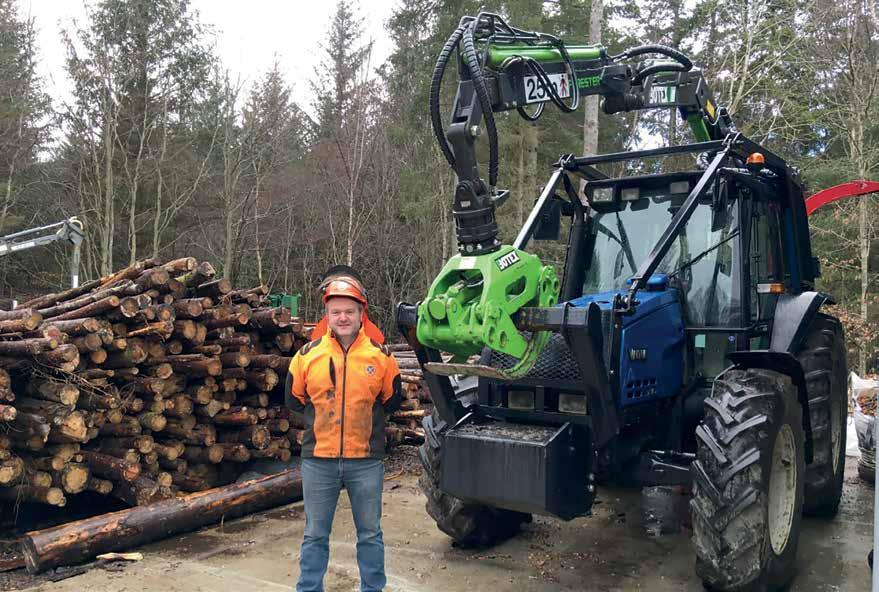
the hammer versions, mulch size is controlled by the door of the mulcher. If the door is left open, material can exit the drum fairly early in the process. If the door is kept closed, material stays in the drum and gets broken down into smaller pieces.
I have chosen just a few manufacturers of mulchers which I think best represent the products available in the UK, but there are numerous other makers out there. Things to be aware of if you are purchasing one should include guarding the base machine, the oil flow (hydraulic drive), and if a case drain (or third line) is required for correct

companies will have moved into the new fi nancial year, and thoughts of upgrading or indeed adding to the fleet may well be at the front of your mind. However, another result of both the conflict and of COVID-19 has been the huge lead times experienced for deliveries. Keep in mind that second and third quarter 2024 are currently being quoted for the supply of certain items, wither that is due to a lack of staff, raw materials or both.
This month I am going to have a look at some of the mulchers on the UK market. An item which is designed for vegetation
pulverise woody plant material, destroying it, and leaving the residue on the ground to degrade but hopefully to limit regrowth too. In terms of the cutting mechanism, there are three main versions available – a chain mechanism, much like an old-fashioned swipe on a tractor; swinging hammers; and fixed hammers.
The chain version is ideal for gorse and relatively small diameter material; swinging hammers are suitable for similar materials to the chains; fixed hammers are for large diameter woody material and generally have a higher horsepower requirement. For
Whilst there are several models within the Slagkraft range, it is really only two that we are interested in – the SH150-60-TW-90 and the SH150-80-TW-90. These two models are designed for mounting on an excavator, while the other models are designed for use on Slagkraft’s own crane system c/w power pack – essentially making use of a loading shovel or other prime mover to move the machine.
You may well have seen videos of these machines also being fitted to older harvest-
continued on page 59
The complete well-maintained & presented contents of MORGAN
Over two days and including:
DAY ONE: Two Weinig Raimann ProfiRip KM 310 M multi-rip saws (2007 & 2004) 2016 Weinig Powermat 1500 sevenhead automatic planer/moulder 2001 Weinig Unimat 30 EL and 1999 Weinig Unimat 23 EL seven-head planer/moulders 2004 Weinig Profimat P26 Fortec four-sided planer with fifth spindle Four Stenner resaws & eighteen Wadkin cross-cut saws, planers/thicknessers, etc
A Forestor 150 electric horizontal band saw 2017 Striebig Compact 11 type 6164 vertical panel saw 2007 Viet S1 211TM 220 twin-head calibrating sanding machine 2014 RanHeat 600kW bio-mass boiler system (RHI qualifying) Over 60 lots of profile cutters, cutter blocks and tooling, including HSK85 PowerLock cutter blocks Five forklifts (Heli/Halla/Lasing Bagnall), two Bradshaw tow tractors & five side-loaders (Linde/Lancer Boss/COMBiLiFT) Two Volvo BM LM 841 wheeled loaders, with various attachments Sixteen lots of Stakapal and Atol heavy-duty cantilever racking Dust extraction equipment ( Dustraction) and air compressors (Hydrovane) DAF/LDV/Nissan dropside and curtainside

Over 140 towable trollies (in over thirty-five lots) Over 50 lots of engineering equipment & hand tools
Machinery Bidding Closes:





Wednesday 26 April 2023 from 12noon
DAY TWO: Over 750 lots of rough-sawn, planed, moulded and sheet, softwood and hardwood timber in pack sizes ranging from 0.5m³ to 4m³. Species include American White & Red Oak, American Ash, American Tulipwood, American Tulipwood, American Black Walnut, American Hard & Soft Maple, American Cherry, European Oak, European Walnut, Steamed & Unsteamed Beech, Iroko, Sapele, Utile, Meranti, Machined Meranti, Hardwood Decking, Opepe, Cumaru, Massaranduba, Siberian Larch, and Douglas Fir
Stock Bidding Closes:
Thursday 27 April 2023 from 10am
Viewing Days:
Monday 24 and Tuesday 25 April 2023
At: Morgan Timber, Knight Rd, Rochester, Kent, ME2 2BA Further information, registrations, and online bidding available at https://auction.marriottco.co.uk/




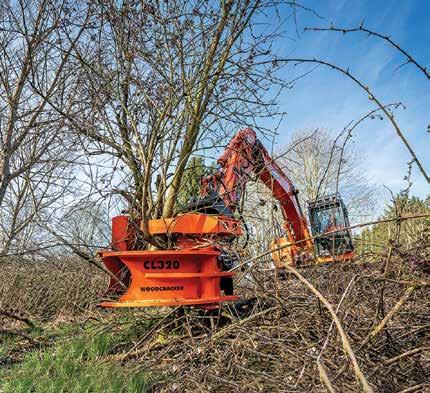
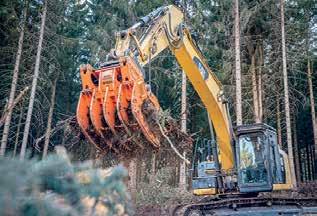



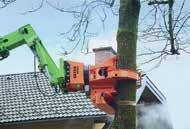
ers for roadside vegetation management, so they are quite adaptable.
The TW range are designed for off-highway application, mounted to either an excavator or backhoe, and are supplied with oil flow from the base machine. In an excavator application, this will likely be from the hammer line. The Slagkraft machines we are looking at are of the chain variety.
Both machines are 1,500mm wide and weigh in at 530kg and 540kg respectively. The big difference for us is the hydraulic motor size – the SH150-60-TW-90 having a 60cc motor whilst the SH150-80-TW-90 has an 80cc motor. As a result, minimum oil flow requirements are 80 and 100 litres/ minute with ideal flows of 95 and 130 l/min being required.
FAE offer mulchers suitable for attachment to a variety of different base machines and power options. For example, tractor mounted/PTO powered, excavator/hydraulic powered, and also their own dedicated tracked carrier.
Within the tractor mounted range, there are nine different machine ranges. These vary from a power requirement of 50hp up to 500hp, shredding capacities of maximum 150mm up to a maximum 500mm and working widths from 1,500mm up to around 2,500mm. Both swinging hammers and fixed hammer models are available, and most can be adapted for front mounting too.
Perhaps a range worthy of mention is the UML/Low, available as either 1,500mm or 1,800mm working widths, these models are designed for use with physically lower tractors e.g. crawlers and vineyard/compact tractors and are designed to keep the PTO shaft at an acceptable angle.
Again, the excavator mounting range comprises a huge number of machines –with 15 model ranges available. Though they are designed for excavator mounting, there is a machine to fit most tracked bases from 1.5 to 36 tonnes! Maximum cutting diameter is 40cm, with flow rates of up to
300 litres/min required. The smallest PML/ HY 50 comes with a 500mm working width and weighs around 180kg. A model this small does not come with a hydraulic door.
FAE produce three tracked carriers, from 175-475hp. A variety of attachments can be fitted to the machines, including stone crushers, stump grinders and of course mulchers. The largest 500/U mulcher is capable of mulching up to 500mm and is equipped with up to 96 teeth on the 250 model, depending on the rotor type. A seriously aggressive piece of kit!
The Italian manufacturer Seppi produce a range of machinery, but in terms of mulchers they produce machines suitable for tractors excavators and skidsteer style loaders. There are five ranges within the tractor mounted series, with horsepower requirements from 60 to 500hp.
Within the PTO offering, the Midiforst dt range is available with working widths of 200, 225 or 250cm. Horsepower requirements of between 120 and 240hp are recommended for this range – certainly not an uncommon tractor size nowadays! The maximum cutting capacity is 30cm. ower supplied via PTO is transferred to the rotor via two sets of five belts – one set on each side of the machine.
As with their PTO range, Seppi offer several ranges within their excavator offering. Available for machines ranging from 2 to 35 tonnes. The BMS-L range is suitable for fitting to excavators ranging from 7 to
15 tonnes, again quite a common excavator class. These machines can be fitted with a forestry rotor which increases cutting capacity to 15cm. The rotors can be spun in either direction, and it is not uncommon for operators to favour hammers with two cutting edges on them – keeping one edge for dirty/abrasive work and the other for clean work so that a tidy finish is left.
Finally, the SMWA skid steer mounted mulchers are available with working widths of 155 or 175cm, or 200cm for the SMO model. These machines are designed to fit onto “Bobcat” style skid steers and really designed to manage smaller sized material up to 5cm diameter (7cm for the SMO).
Bomford offer two machines in their Buccaneer range of tractor mounted mulchers: the SD fitted with swinging hammers and the HDX fitted with fixed hammers. Minimum power requirements are 110 and 120hp respectively, and working widths of 2.2m.
Ù also offer their Flailbot range, compact remote controlled tracked carriers, ideally suited to bankings with their ability to work on slopes of up to 55°. The top of the range Flailbot Supreme Stage V/T4 Final can be fitted with a 1,500 mulching head (1,650mm cutting width) which can be ordered to suit either swinging hammers or the heavier duty fixed hammers.
The remote control has a working range of up to 150m. This style of machine is proving popular with contractors maintaining motorway embankments.
Whilst German manufacturer Ahwi (now Prinoth) do produce excavator mounted mulchers, they are perhaps best known for their PTO mounted mulchers and tracked carrier/mulcher combination.
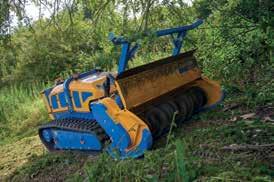

With six machines in the tracked range, including the recent addition remote-controlled Raptor 100, the conventional tracked offering varies from 175-630 horsepower. The smallest of the conventional range, the RT 200 can operate other accessories including stump grinders via its 3-point linkage and conventional PTO drive.
At the other end of the scale, the Raptor 800 (weighing in at a huge 20,750kg) can be fitted with the M900 mulching head. To accommodate the largest mulching head, a special 4-point linkage is fitted to the Raptor 800.
The PTO machines are well thought of too, and Ahwi offer six machines in this range. PTO machines have a power requirement of 80-500 horsepower (at the PTO) so surely something for everyone. The M450, with working widths from 1,900-2,700mm, is the entry level machine with minimum power requirements of 80 (1,700mm working width) up to 120hp (2700mm working width). The Ahwi PYO mulchers are only available with fixed hammers.
Extensive range of compact tracked ‘Spider’ access platforms

Compact machines able to access difficult to reach areas
Manoeuvres through standard gateways and narrow paths
Off Road
Heavy Recovery
We go all over the country recovering machines that have sunk or got in trouble in soft ground.



Workshop
We undertake any chassis, body or engine conversions.
Joe: 07739 109257
Robert: 07711 233112
Office: 01948 780257
www.jrmillingtonltd.co.uk
joe-millington@hotmail.co.uk
Track widening system and greater ground clearance
Established 1999
WANTED: TO PURCHASE LARGE QUANTITIES OF ENGLISH OAK & SWEET CHESTNUT STANDING FELLED OR AT STUMP –ALL ROUND TIMBER BOUGHT AND SOLD. Call Jonathan 01580 819179 or 07759 567801 or contact David 07769 354118
www.southeastforestry.co.uk

All of our forestry products are harvested sustainably from managed woodlands and forests
Local Sustainable Renewable - South East Forestry Group WE BUY WE FELL WE SELL TIMBER

It was very interesting to revisit the Subaru family and test its worldwide best seller, the Outback. This is a real big seller in the USA but Subaru suffers from low sales in the UK.
However, back in the late 1980s when I stated my forestry career at Bangor University (or I should say, University College of North Wales) a Subaru Estate was the default car for most foresters. It was more or less the only 4WD Estate on the market. They were tough and reliable - a friend who ran many Subarus once told me that the trouble with them was that they become a bit unreliable after 200k miles!
A few years ago, Subaru ceased producing and fitting diesel engines to its cars. The Outback is only available with the 2.5 litre petrol flat twin engine mated to an automatic gearbox, and in my hands averaged 31mpg. The official average figure is 33 mpg, which I would have no doubt reached eventually.

Subaru did recently launch a new electric vehicle soon to arrive in the UK, but for now the range is all petrol with no PHEVs about.
This new Outback that launched two years ago does stand out more than the one it replaced. It has quirky plastic cladding around the wheel arches and more edgy front and rear styling. It does look much better, more distinctive and appealing. It is a large car being 4,870mm long, 1,875mm wide excluding mirrors, and 1,675mm high.
Three models are available and priced at £36k for the entry model named Limited, £41k for the Field, and £42k for the top of the range Touring. It has a large boot at 561 litres with seats in place, and a useful 1,822 litres with the rear seat folded flat. A sunroof reduces the volume by 72 litres.
The fuel tank holds 63 litres - good for about 400 miles, which is okay but I prefer at least 500 mile range if possible. That
was easily the case in the old diesel and now in its often replacement the Skoda Octavia Estate Scout Tdi. I remember the Discovery 2 had a 92-litre tank.
Most foresters now drive pick-ups, encouraged by the current BIK system which is not helping the environment much. The Outback weighs 1,646kg and can tow a braked trailer up to 2,000kg. Its ground clearance for a car is good at 213mm. Wheels are 225/60R18s coping with the mellow power distributed by the constant 4WD system and modest engine power of 169bhp and 252Nm of torque from its 2,498cc.
Acceleration is leisurely at 10.2 seconds to 62mph. It could do with some more power but, once up and running, the car is plenty fast enough. The gearbox is an automatic Lineartronic device with only one gear made to sound like six. It works well and the car is nice and quiet.
continued on p63
Eamonn Wall gets behind the wheel of the latest Subaru Outback and finds himself reminiscing about days past.


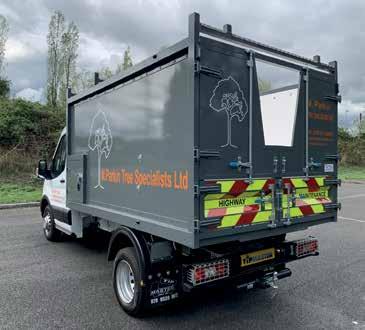








continued from p61
The interior is a mix of buttons and a screen that is smaller than it appears as its sides are not part of it. An easy car to jump in and drive, all the controls are where you expect them to be.

Headlights are LED with auto Leveliser and pop-up washers. Other model dependant goodies include heated front and rear seats, heated steering wheel, auto power folding door mirrors, automatic rain-sensing windscreen wipers, rear seat release lever in boot space, keyless entry and push button start system, power tailgate with handsfree function, auto vehicle hold and rear parking sensors, XMode hill decent control, engine stop start and more.
The auto holding electronic device, which is now a very common feature on most cars, certainly aids driveability, stopping the car rolling backwards when taking off on a steep hill. Subaru was one of the first manufacturers to fit such a device and it was mechanically operated.
The Outback is a nice car to drive. It fits into the country life really well with its constant 4WD and good ground clearance. Okay, it’s no Discovery 4 when it comes to ground clearance, but it will be good enough for many folk. The dashboard is well laid out and I liked the white instrument dials.
The car drives well and is well sprung. It has a comfortable ride and handles

and brakes well. The front door windows comprise a main pane of glass and a wee fixed pane at the front corner, just like that found in the new Range Rover. It looks good for increasing visibility. The seats are comfortable, and I liked the perforated leather.
With petrol now 20p per litre cheaper than diesel, the attraction of the Outback petrol is more apparent. It is a very good car but most need 40mpg plus. However, for a niche part of the market, it is now a much more appealing car.




Eamonn Wall FICFor is a forestry and arboricultural consultant and Director of Eamonn Wall & Co Woodland Design and Management.


Julian explains the opportunities that await in woodland tutorials for sharing valuable knowledge with forestry newcomers.

Last week (as I write), I enjoyed breakfast with Dr Keith Kirby, one of our (if not the) foremost woodland ecologists. We were at a meeting of some 80 scientists and practitioners concerned about tree health, principally acute oak decline (AOD).
Our conversation turned to our shared interest and commitment to writing about our work to pass on what a life-long career has taught us. We both feel hugely privileged for working in our professions, but also a sense of responsibility to those now starting out or in mid-career.
There’s nothing new in one generation passing on its accumulated wisdom to the next; it is the basis of education. But what is the best way for sharing knowledge of trees, woods and forests when they themselves mostly outlast us? And how can the small woodland owner do their bit?
This topic of memory and mentoring has come to the fore, both by my being asked to help with young scientists and from an initiative by the SE(E) regional Forest and Woodland Advisory Committee (FWAC). With high levels of staff turnover across our industry and many new entrants coming from non-forestry backgrounds, the idea was mooted of having an informal network both to build contacts and to meet on-site.
Again, nothing new there, except for the site meetings at which any question can be raised. We all know the embarrassment of wanting to ask something when we suspect most present will know the answer, so we keep quiet not to look dumb. But in the first few months in a new job this is not so, indeed asking such questions is welcomed. And this is what was laid on one Friday afternoon in a small woodland.
All sorts of topics were raised by those present – timber prices, principles of conservation in woodlands, how to find out about woodland history, grey squirrel control, access rights, plastic waste in woods, continuous cover forestry etc. It was a smorgasbord of topics and as we went round, a thought occurred to me.
Keith and I have written much about ecology and silviculture respectively, and our books have been published, but what the Friday afternoon showed was that there was a place to answer just the question raised to fill the knowledge gap. There was no need to read a whole chapter or look up references in an index: the
mentor could meet the ‘mentee’ at exactly their point of need.
It was a woodland tutorial. An obvious enough point, perhaps, but it has encouraged me to support more such opportunities. I think all of us who own woods can share them in this way with what we have learned.
Of course, a whole industry of conferences, seminars, webinars, publications, social media posts and podcasts exists to do all this. Indeed, scientists have to write
and get their research published to advance, but the onus is also on the reader to read it – even the articles and features in this magazine!
And there’s the rub: with our hectic schedules, deadlines and workloads, how to find the time? An afternoon in a wood and being able to ask anything both provides the time and the attention – the only distraction is ‘I wonder what that’s all about?’, and being able to ask – perfect mentoring.
Corporate memory, too, is hugely important. Again, none more so than in forestry with our long timescales, evolving policies and priorities, and increasing public interest in what we do and how we do it.
So, let’s take every opportunity to pass on what each of us has won from the best of classrooms, and actually managing and caring for our woodlands. And let’s read old textbooks too, even John Evelyn’s 17th century Silva still has some precious nuggets!
“THERE’S NOTHING NEW IN ONE GENERATION PASSING ON ITS ACCUMULATED WISDOM TO THE NEXT; IT IS THE BASIS OF EDUCATION.”






Robinson Forestry has facilitated planting over 15,000 new trees as part of an expansion of The Deer Park’s popular woodland walk – with all saplings protected with Tubex Recyclable Tree Shelters. Completed at the beginning of 2023, The Deer Park’s changing landscape project has seen the creation of 15.7 hectares of new woodland and parkland.


COMING UP IN JUNE 2023 – GET INVOLVED
Forestry in Pictures is a regular feature in FTN. For every issue, we select the most impacting photograph sent by a reader. If you have a photo you would like to see published here, please send your file to ftn@confor.org.uk. Please include your name, a short comment text to go with the picture, and an image credit. Photos should relate to forestry and timber and be of high-quality (minimum resolution 300dpi). Exceptional pictures might be considered for the front cover of a future FTN issue.
By submitting a picture to Forestry in Pictures you give Confor permission to use the file for non-commercial purposes in Forestry and Timber News or the Confor website. Photos will always be credited.
In June we will be running a feature on Innovation, Technology & Woodfuel. Remember that FTN is your magazine – get in touch if you want to suggest editorial or give us feedback on articles we have published in the past. Confor members, send us your company’s news updates or pitches for feature articles. Note that our general editorial deadline for the June 2023 FTN is 10 May 2023. If you would like to pitch an article idea, please do so by the end of April 2023.









































